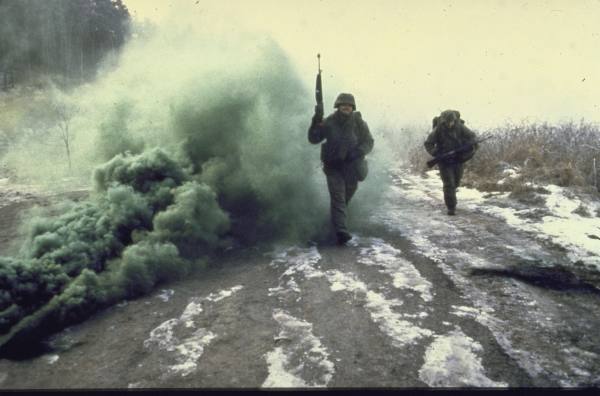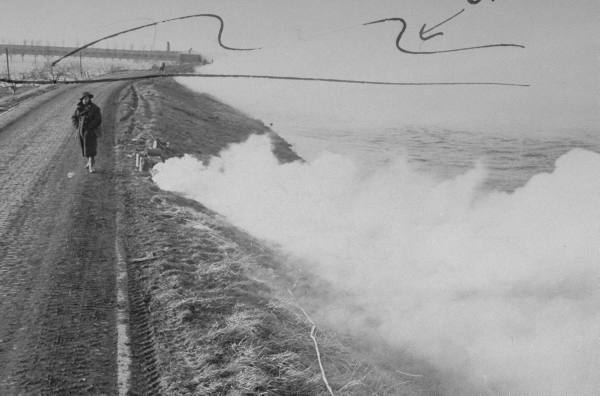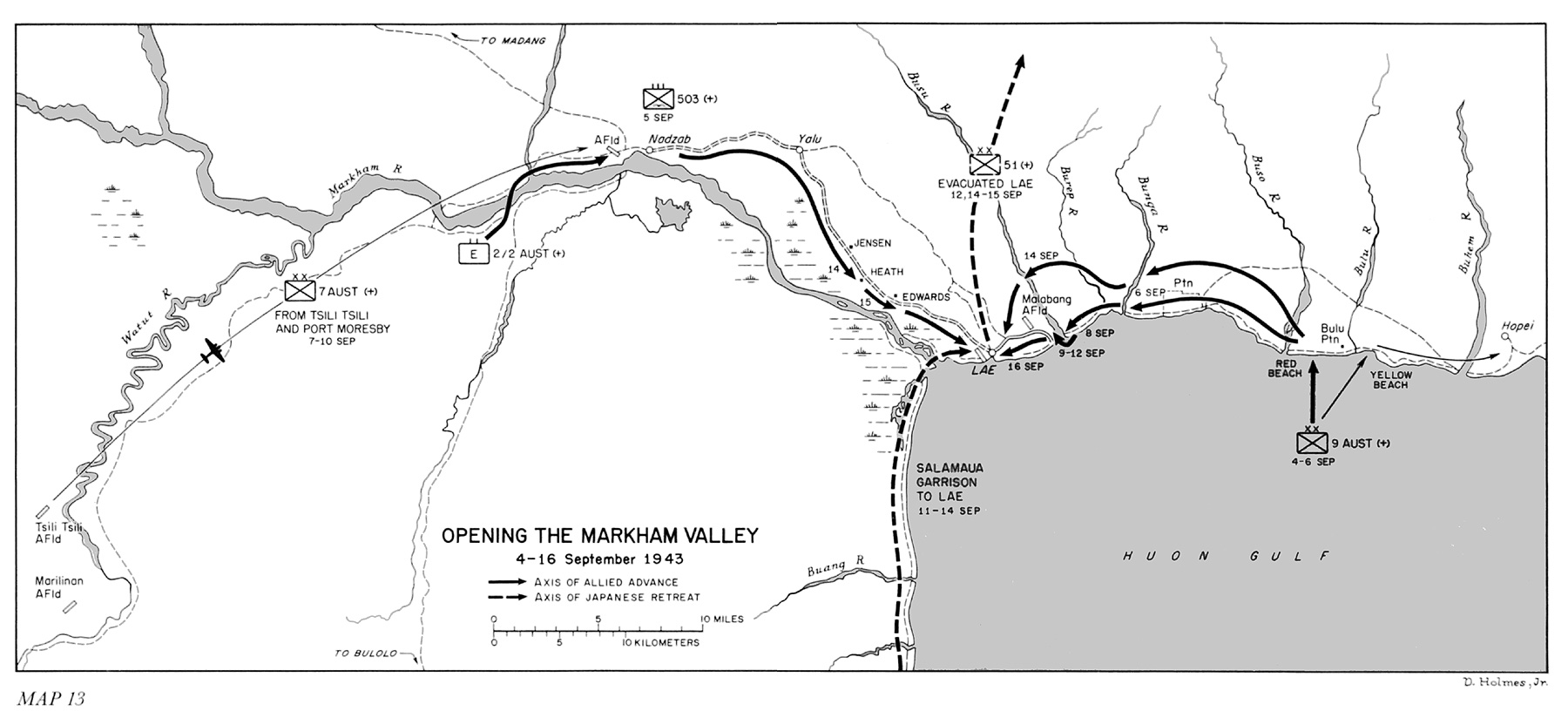UPDATED 22 April 2011
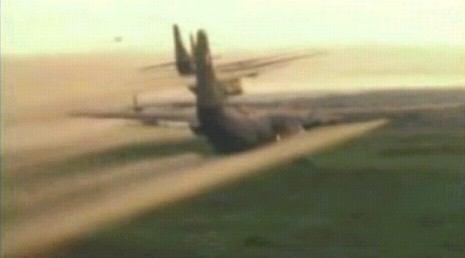
Researching the actual Omaha Beach landings depicted so astonishingly by the film, "Saving Private Ryan", you will find a conspicuous absence of smoke screens being laid by supporting arms, except on the British and Canadian Beaches where special Sapper Tanks ("Hobart's Funnies") lead the way through enemy obstacles.

The casualty-conscious British were better prepared on D-Day than the U.S. was, and the light casualties the commonwealth forces experienced prove this. As the high explosive supporting fires shifted inland when the troops landed in unarmored craft, nothing filled this void to deter enemy aimed fire and thousands of men were cut to pieces--except in a small area of "Dog" sector where an accidental grassfire created a smokescreen, and the troops landing there were remarkably unhurt.
http://www.army.mil/cmh-pg/100-11.htm
Page 45"There were fortunate exceptions to this general picture. Several hundred yards of bluff west of les Moulins draw were obscured in heavy smoke from grass fires, apparently started by naval shells or rockets. Blanketed by this smoke, enemy guns and emplacements were unable to deliver effective fire on that end of Dog Beach, and units landing there were comparatively unscathed. At other places, what would seem to be an occasional "blind spot" in the enemy fire pattern let a craft get men ashore with few losses. In the main, the first wave was hard hit."
"To their right and left, Company "C" and some 2nd Battalion elements were crowded against the embankment on a front of a few hundred yards, the main Ranger force was about to come into the same area, and enemy fire from the bluffs just ahead was masked by smoke and ineffective."
"An unscheduled gap of more than a thousand yards separated Company "A" from the next unit of the 116th RCT [Regimental Combat Team]. Instead of coming in on Dog White, Company "G" landed in scattered groups eastward from the edges of Dog Red. The three or four boat sections nearest Dog Red, where smoke from grass fires shrouded the bluff, had an easy passage across the tidal flat. Most of the men were halfway up the flat before they became aware of sporadic and inaccurate fire, and only a few losses were suffered. In 10 to 15 minutes after touchdown this part of the company was behind the shingle bank, in good condition. Officers, knowing they were left of their landing area, were uncertain as to their course of action, and this hesitation prevented any chance of immediate assault action. Further east on Easy Green, the other sections of Company "G" met much heavier fire as they landed, one boat team losing 14 men before it reached the embankment."
"Company "F" came into the beach almost on its scheduled target, touching down in front of the strongly fortified les Moulins draw (D-3). The 3 sections to the east, unprotected by the smoke, came under concentrated fire and took 45 minutes to get across the exposed stretch of sand. By this time half their number were casualties; the remnants reached cover in no state for assault action. The other sections had better fortune, but had lost their officers when they reached the shingle bank and were more or less disorganized.
"This completes the story of the first assault wave on half of Omaha Beach, for the fourth company (E) of the 116th, supposed to land on Easy Green, veered a mile eastward from that sector."
So Where the hell are our U.S. Smokescreens, Today?
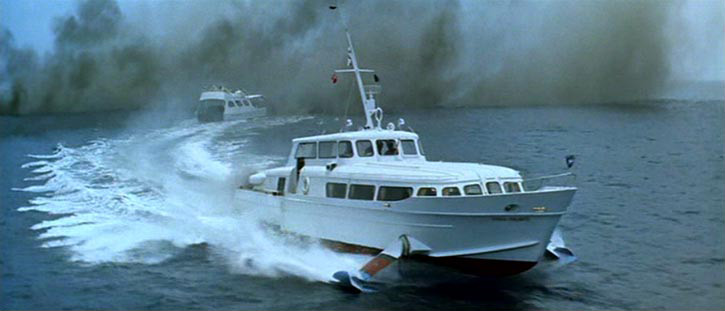

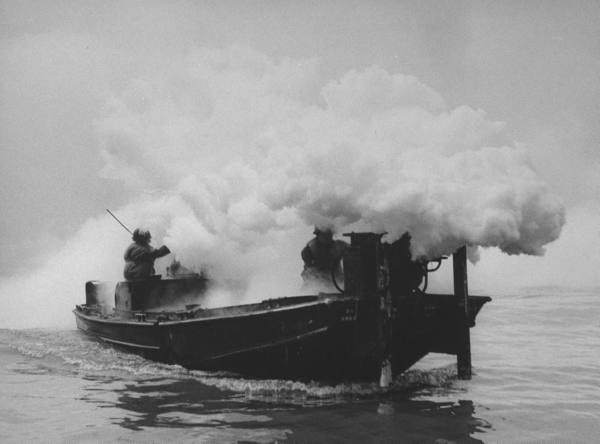
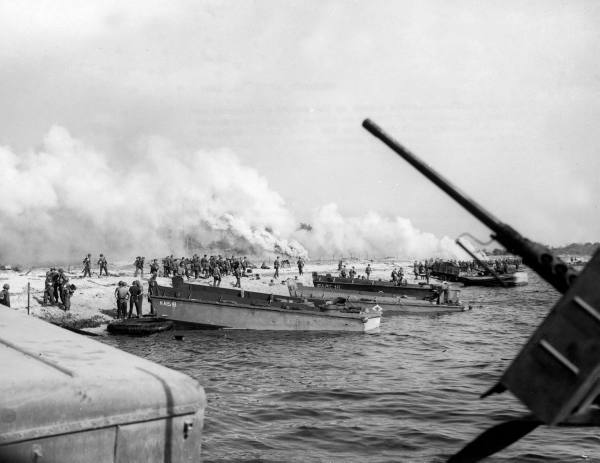
Royal Navy Intelligence Chief, Commander Ian Fleming wrote smokescreens into the screenplay of the movie adaptation of his book, Thunderball: indeed, James Bond is For Real; Hollywood is better equipped than our post-WW2 forces today! Fleming planned many naval operations and British landing craft could lay smoke. What's our excuse for today not being able to lay smoke when PGMs are even more lethal?
That U.S. commanders did not lay smokescreens on D-Day was crimninal incompetence since a year before in the Pacific, Kenney dropped Paratroopers masked by smokescreens laid by A-20 Havoc aicraft. The "right hand did not know what the left was doing".
It never ceases to amaze me how military bureaucracies can smother and disintegrate sound military practices by conformity non-sense executed by weak co-dependants who do not study their profession and only want to get by doing the day's routine at lowest common denominator "standards". The smokescreen is yet another tragic example of a military practice we need to be executing today to a high standard--but are not because no bureaucratic element is championing it and it threatens the egos of the gunslingers. Army Chemical Corps is supposed to be in charge of smoke-laying but does so only in a lukewarm and uninspired piecemeal way at places like NTC thanks to "killer" combat arms commanders looking down on them and their screens that could detract from their gunslinger glory. And there is no element in the U.S. military with an AIRBORNE smokescreen capability like we used to have with A-20 Havocs in WW2 and OV-10 Broncos, UH-1 Huey helicopters during Vietnam. Field artillery officers cannot shoot smokescreeens during war practices because of the threat of starting grass fires.
 Video: Fort Polk, La Joint Readiness Training Center (JRTC) Failure
Video: Fort Polk, La Joint Readiness Training Center (JRTC) Failure
 www.youtube.com/v/OuLiW6yxITE
www.youtube.com/v/OuLiW6yxITE
During my rotation at JRTC in 2000, the light infantry narcissist (LINie) commander of 2-505th PIR refused to employ the smoke Humvees attached to us even when confronted with assaulting Shughart-Gordon MOUT village where smoke would have blinded the enemy and won us proximity and dominance. Instead to max his gunplay playing time we all died without smokescreens first with the foot infantry charging wire and inter-locking machine gun fire on their own, then with our tracked tanks going at it alone in piecemeal fashion after the LINies had died. There must be OVERLAPPING layers of smoke for the capability to be fully effective to its maximum potential; if all you do is lay smoke ON YOURSELF (defensive smoke) as you pass by an enemy its certainly better than nothing, but it should be coupled with SMOKE ON THE ENEMY (offensive smoke) to blind him from seeing ahead at all.
Military Disaster without Smokescreens Case #1: Nasiriyah 2003
 Video 1
www.youtube.com/watch?v=Ha4x5c4xBFE
Video 1
www.youtube.com/watch?v=Ha4x5c4xBFE
To see what can happen if you don't have smokescreen, look at the USMC debacle at Nasiriyah, Iraq in 2003 when they tried to foolishly drive wheeled trucks and bloated Amtracks down the main road leading through the town with buildings alongside full of rocket-propelled grenade (RPG) gunners..
 Video 2
www.youtube.com/watch?v=a10F5CBHAZE
Video 2
www.youtube.com/watch?v=a10F5CBHAZE
The consequence of the USMC's smokescreen incompetence was heavy casualties and being pinned down by mere Iraqi rearguards such that they were 6 days late reaching their assigned sector in east Baghdad as the fully tracked, mechanized U.S. Army 3rd Infantry Division (Mechanized) waited holding West Baghdad. While the marines were AWOL/UA reaching east Baghdad, looting broke out; destroying the key police and governmental infrastructure needed to restore order and Saddam Hussein and subordinates escaped to start a rebellion against us that has so far cost us over 4, 236+ dead, 26, 000+ wounded and $1 TRILLION+ of costs that have harmed the U.S. economy.
Not employing smokescreens can have STRATEGIC consequences.
The USMC has no excuse because some of the tracks they did have like the AAV-7 Amtrack HAS AN ENGINE-GENERATING SMOKESCREEN capability, but in typical slacker gyrene ad hoc mentality, the marines had never trained together to at the same time to do mechanized warfare and certainly hadn't trained with smokescreens to get before the war a capability to mask their columns while on the move alongside an urban area.
Military Disaster without Smokescreens Case #2: Lebanon 2006
Despite warnings by many to include this author in 1998 in U.S. Army ARMOR magazine and tragic losses of life when hit by Islamic fighters shooting anti-tank guided missiles (ATGMs) targeting specific vulnerable locations on tanks like the turret/hull junction, the Israeli Defense Force (IDF) in 2006 got lazy and attacked Hezbollah positions frontally in Southern Lebanon without smokescreens; suffering heavy casualties to guided missiles.
Military Success Story with Smokescreens, Gaza Strip 2008-9
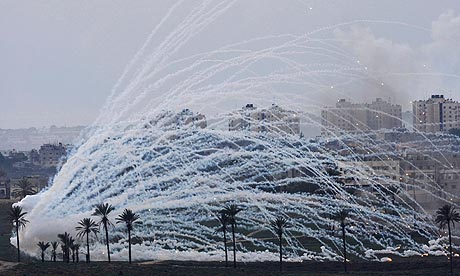
Fortunately to the IDF's credit and a reminder to ourselves that we are behind the power curve, in their recent intervention into Gaza to stop malcontent rocket shooting over the successful border fence system, they projected smokescreens by White Phosphorous (WP) artillery shells to blind enemy RPG and possible ATGM gunners and suffered few hits and casualties.
http://news.aol.com/article/israel-gaza-conflict/232890
EXCERPT:
Palestinian witnesses said Israeli forces fired phosphorus shells early Sunday at Khouza, a village near the border, setting a row of houses on fire. Hospital official Dr. Yusuf Abu Rish said a woman was killed and more than 100 injured, most suffering from gas inhalation and burns.Israeli military spokesman Capt. Guy Spigelman denied the claims. One of the main uses of phosphorous shells is to create smoke and mask ground forces, which is legal under international law, but the chemical can be harmful if used in densely populated areas.
WW2: Won by Smokescreens--but don't Expect Hollywood to Show You This!
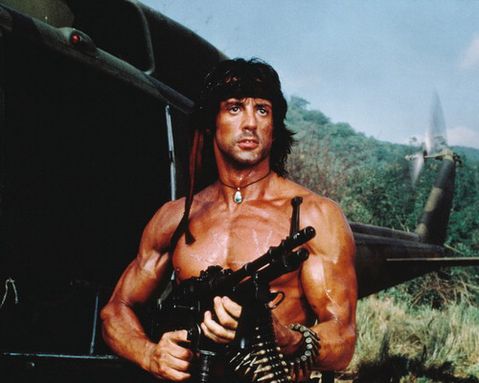
So if smokescreens are so damn effective, why doesn't the current generation use them as part of an INSTITUTIONAL knowledge instead of waiting to get bloodied and come to this conclusion by body bag and flag-draped coffin?
First, the military is a haven for weak people who want to hide from life. The military offers a set routine and a dangerous illusion that if you simply follow this set "formula" you will be successful without active participation, intellectual curiosity or argumentative struggle. This is well-documented and proven by WW2 British Army combat engineer Dr. Norman Dixon in his book, On the Psychology of Military Incompetence. Weak lemmings don't study their profession for tricks to help win because they think all they need to do is blindly follow whatever the bureaucracy is doing and success will magically materialize. If they had studied their profession if they were professionals and not time servers, they'd study things like WW2 in DETAIL--by perhaps reading Army General James Van Fleet's biography, The Will to Win. Its an ironic title because this is exactly what we lack today, what we have today is a WILL TO DO BULLSHIT; not whatever it takes to win--which may mean a bummer for your ego's preferred methods like feel-good gunslinging.
Reading about Van Fleet you will notice that as commander of the 90th Infantry Division he did several RIVER CROSSINGS where smokescreens by artillery and smoke pots were critical to his success. Now the victories came about by his men fighting with guns but imagine a Hollywood director filming a battle scene with no Rambo-like gun play because everything is white from smoke. It doesn't happen. The closest we have is Sir Richard Attenborough's depiction of the M4 Sherman 75mm tank shell-generated smokescreen used during the river crossing in "A Bridge Too Far". So if Van Fleet was so successful with smokescreens during river crossings in WW2, why hasn't this practice continued? As stated above the smoke shells cause fires so the safety nazis have this nixed. However an even more insidious problem is that WE DON'T DO RIVER CROSSINGS ANYMORE even though most of our vehicles cannot swim; only our M113 Gavins can swim but the risk-averse Army bureaucracy is to cowardly to exploit this for tactical and operational benefit. Moreover, the 90th Infantry Division does not exist! It was one of the 100 Army Divisions created to win WW2 that was disbanded afterwards and with it went its river crossing expertise. What I'm saying is that battlefield wisdom is DIRECTLY CONNECTED TO THE MEN WHO LEARNED IT since 99% in the anti-intellectual U.S. military lemming bureaucracy actually reads and studies their profession. So IF MEN WHO DID SMOKESCREENS ARE NO LONGER IN THE SERVICE TO REMIND EVERYONE OF THE TACTIC, TECHNIQUE OR PROCEDURE FROM THEIR OWN PERSONAL EXISTENTIALISM, IT WILL NOT BE IN THE GROUP MIND TO BE DONE.
No 90th ID vets in the army, no smokescreens. No A-20 smokescreen pilots in the Army or USAF; no smokescreens. No OV-10 or Huey pilots who used smokescreens in the Army or marines, no smokescreens. Placing a good TTP in a manual sadly doesn't cut it because weak egomaniacs don't respect that what's in them came from actual men earned in blood the hard way. They are obsessed with trying to validate their own weak egos and will only learn if they experience it directly themselves; ie; they have to get killed or wounded or lose a battle in a clear FUBAR before they will learn anything--and even then they can conjure up the excuse that "it was a hard fight, we did the best we could" draping themselves in the American flag as a final excuse to subsidize their incompetence and preserve the BS bureaucratic status quo. This is why the USMC must be disbanded as it always reverts to whines about their heroism when confronted with their clear stupidity and lack of foresight and preparation.
Warning for the Future if the U.S. Military Doesn't Reform and gain Multi-Layered Smokescreen Capability
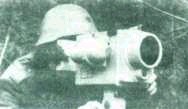
Sensors and computer chips are now making weapons increasingly guided and lethal. It behooves us to counter precision guidance by MASKING ourselves with Multi-Layered, Offensive and Defensive smokescreens. Had the Iraqi rebels in Nasiriyah been Hezbos with ATGMs and not just Fedayeen with RPGs, the entire USMC column would have been wiped out. Multiply this if conceiving an invasion of an Iran that has thousands of ATGM gunners backed by a combined-arms team with artillery, mortars and an air force willing to challenge our own which would be very far from home and thirsty for fuel. A replay of the Kasserine Pass or Chosin reservoir is not that far removed from an incompetent U.S. military begging for a bloody nose by willful ignorance and incompetence. The margin bewteen our dominance and disaster against a competent enemy is not that great. We need to use EVERY tool at our disposal to its fullest or we risk another Task Force Smith.
The RMA types in DoD like to pontificate about "precision guided munitions" (PGMs) yet do nothing to get off our asses and disperse and camouflage and harden us into BATTLEBOXes capable of evading or failing that withstand high explosive attacks. One way to defend against PGM attack would be multi-spectral smokescreens to cover our forward operating bases (FOBs). The Germans in WW2 successfully defended the entire city of Brest using large-scale smokescreens. We need to gain a modern version of this capability to protect our FOBs.
www.lonesentry.com/articles/ttt/german-area-smoke-screen.html
"German Area Smoke-Screening" from Tactical and Technical Trends
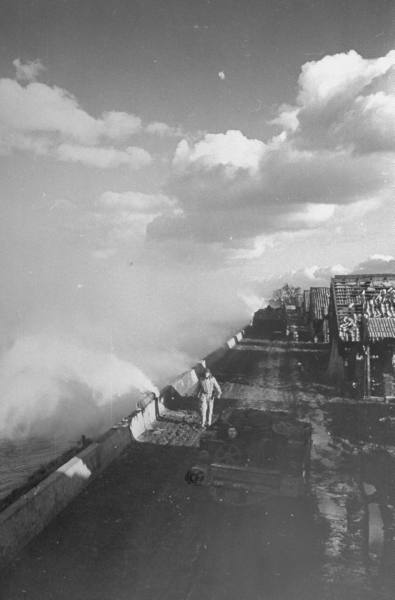
A report on German smoke-screens to protect cities, harbors, and area targets from aerial bombing attacks, from Tactical and Technical Trends, No. 24, May 6, 1943.
[DISCLAIMER: The following text is taken from the U.S. War Department publication Tactical and Technical Trends. As with all wartime intelligence information, data may be incomplete or inaccurate. No attempt has been made to update or correct the text. Any views or opinions expressed do not necessarily represent those of the website.]
GERMAN AREA SMOKE-SCREENING
*
Numerous reports indicate that the Germans have found the use of smoke screens at night to have considerable protective value against enemy bombing attack. This has been particularly true of the coastal areas, where unscreened coastlines offer a ready means of calculating distances accurately. In inland areas, where targets are not so easily located, smoke screens are generally limited to the protection of precision targets of prime importance. However, there are indications that several of the larger inland cities are protected in this way. In addition, decoy smoke screens have been effectively employed upon a number of occasions to protect nearby targets.
Relatively few instances of daylight screening have been reported to date, and on the whole the practice has not proved particularly effective. With the increasing frequency of daylight raids over the Continent, it is to be expected that the Germans will take steps to protect vital target areas with efficient smoke screens both day and night.
The Germans have used smoke extensively for screening:
(1) Battleships, docks, and naval installations;
(2) Oil refineries and storage;
(3) Important blast furnaces, factories, and buildings;
(4) Canals and harbors.
The most exact knowledge of large-scale smoke operations comes from Brest, where several large German battleships and cruisers were successfully protected from enemy bombing over a very considerable period of time. A screen was put up immediately upon the sounding of an air raid warning, and within 20 minutes the docks and town were completely enveloped in smoke. It is reported that the screen was so dense that visibility on the ground extended for only a few yards.
The generators appear to have been of the Smoke Generator 41 type, consisting of a 40- to 55-gallon steel drum fitted externally with a stopcock and a steel projection tube. They contain 20 gallons of a chlorsulfonic acid and sulfur trioxide smoke mixture, which is expelled by means of a cylinder of compressed air contained within the generator drum. Alongside the generator, a similar drum of smoke acid was provided for recharging. By this means a smoke screen could be maintained at full strength for 2 hours. The smoke is described as issuing from the generator in the form of a liquid, which immediately vaporizes. It has the color of tobacco smoke and is said to be almost odorless and harmless, but irritating to the throat.
More recent reports indicate replacement of the original equipment with an apparatus similar to the German naval chlorsulfonic acid smoke generator. This consists of two containers, one containing the chlorsulfonic acid and sulfur trioxide mixture, and the other compressed air for atomizing the smoke acid. Obviously, the newer type of equipment provides an uninterrupted generation of smoke over a considerably longer period of time. It is definitely reported that, on at least one occasion, the smoke screen was effective throughout an air raid lasting 4 hours.
The generators were scattered around Brest and its suburbs and along the docks and breakwaters, either in groups of several or at intervals of roughly 75 yards. Additional smoke was provided by about 20 small fishing craft (10 to 12 tons), each provided with a smoke generator. These boats were moored during the day at the end of a jetty, and at dusk were anchored in crescent formation in the harbor 1 or 2 kilometers from shore.
While practically all reports describe the smoke acid as composed of a mixture of chlorsulfonic acid and sulfur trioxide, one report mentions the use of a "weak mixture of titanium tetrachloride and ammonia." It is believed that the Germans have overcome the clogging difficulties formerly experienced with titanium tetrachloride when used in spray generators, and it is known that ammonia increases the density of the smoke.
Aerial photographs showing smoke screens in Norwegian fjords are evidence of the increasing effectiveness of this method of protecting primary targets. There is reason to believe, however, that development has not reached the point where desired results can be obtained irrespective of wind direction. While German warships shown in these photographs were not completely obscured by smoke, the protection afforded appears to have been considerable and would hamper raiding aircraft to a marked degree.
Reports concerning the materials and equipment employed in screening Norwegian coastal areas are less specific. According to a prisoner of war from one Norwegian port, smoke-producing liquid is stored in 40- to 55-gallon drums in the holds of fishing vessels. When poured into the water, the liquid takes the paint off the sides of the boats and causes the putty around their portholes to flake and drop off. A heavy grayish smoke develops, which clings to the water and spreads gradually upward as the concentration increases. On one occasion, a half hour elapsed before complete protection was afforded. This source reports, however, that smoke became effective over a limited dock area in a specific German port in only 5 minutes.
Another unverified report states that the main part of a smoke screen employed in a certain area in Norway was produced by 20 small fishing boats, each manned by 3 or 4 men, whose operations were supplemented by 3 land-based crews. The smoke here was more irritating to the nose and throat than the harmless, odorless smoke produced at Brest. It is said to have incapacitated men working in the vicinity, although cattle in adjoining fields apparently were not seriously affected. According to a Norwegian source, the Germans appeared reluctant to start smoke screens except when a major attack was imminent. The reason for this was not known, although it is suggested that the cost of the operations may be a factor.
It seems quite likely that smoke screen operations in German-controlled coastal areas are aided by minesweepers (R boats), which are reported to be fitted with smoke generators using chlorsulfonic acid and/or oleum. Also, German E boats doubtless contribute to these operations. In addition to carrying two of the smaller smoke apparatus (Smoke Generator '41') aft, one on each side, they are equipped with French smoke floats. The latter apparatus, weighing 40 kilograms (88 lbs.) when filled, contains 32 kilograms (70.4 lbs.) Berger-type** smoke mixture, which burns for periods variously estimated from 8 to 14 minutes.
Certain German cities are reported to be protected by extensive smoke-screen systems. RAF pilots have reported dark-gray smoke screens over Berlin, 20 to 30 miles long and 2 miles wide. The very dense smoke appeared to have come from generators 20 yards apart. (Note: 75-yard intervals appear to be the more normal spacing.)
It is reported from Kiel that a screen of gray-brown smoke covering the entire city is produced from the exhausts of automobiles racing through the streets whenever there is danger of an air raid.
Before the war, the question of pipe-line installations with jets at suitable intervals was discussed in German technical literature. There have been indications of the use of this system to screen certain factories in Germany, such as the Krupp works near Essen. Reports from Greece indicate that a pipe line for smoke screens runs the entire length (4 miles) of the Corinth canal.
*Prepared in the Office of the Chief, Chemical Warfare Service.
**Berger Mixture, named after the French chemist, consists of the following:
Zinc (dust);25 to 30 percent
Carbon tetrachloride 45 to 55 percent
Zinc oxide 10 to 20 percent
Kieselguhr 5 to 10 percent
Yet another Unsung TechnoHero: Patterson and his "Fog Oil", On-Demand Smokescreens
Researching for this web page, it came as no surprise that the on-demand smoke generators we use today were first created by an unselfish technohero who gave his idea to the U.S. government to win the war and was promptly forgotten. We will try to redress this on this web page by re-posting his history that is now gone from a family web site but saved in Google cache.
Someone needs to do a movie on the technoheroes of WW2; if their inventions get in the way of gunplay scenes, then dedicate a movie just to them. The closest we have today is "The Dambusters" which in the first part of the film chronicles the struggles of Barnes Wallis to get his spinning skip bomb placed into RAF use to bust the Ruhr dams. War is technological; while this threatens the weak egos of the stupid people who want to just do kinestetic gunplay, the fact is that SMART people who create war-winning weapons are vital even if they don't serve on the front lines and are seen as "pussies" by the knuckle-draggers. What we need in the U.S. military is a technocracy of thinker-doers as British General Percy Hobart created in all of his war-winning units; SMART people who are also COURAGEOUS. "Stud brainiacs", as surely smokescreen creator Patterson was. It takes courage to experiment with new equipment; many test pilots and inventors have died in their machines so this "pussy" label the dumbass military co-dependant--who has nerver had an original thought let alone created a new piece of equipment or TTP--likes to use only belongs to the man he sees in his own mirror.
http://74.125.47.132/search?q=cache:KuW__JSisSEJ:www.wwiismokescreen.com/+wwwiismokescreen.com&hl=en&ct=clnk&cd=1&gl=us
From Rum Runner to WWII Inventor

Days after Pearl Harbor, Alonzo Patterson, a rum runner turned customs agent, donated to the U.S. government the technology that he once used against them--a smoke screen of a kind that the military had dreamed of but had never been able to develop. Patterson gave up all desire for profit and turned over all of his revolutionary methods, his secret fog oil formulae and 10 portable working smoke screen apparatuses to give his government a needed edge in the war. This smoke screen, developed by a rum runner to avoid confrontation with government agents, would go on to save thousands of lives. This WWII invention saved naval ships from kamikazee attacks, protected paratroopers from enemy gunfire, and obscured amphibious landing invasions from enemy guns. Troops everywhere felt safe under the protection of this smoke screen.
First Successful, Large-Scale Smoke Screen
The development of a smoke screen was tried for over 2,000 years by the world's greatest armies: the Romans, Vikings, British, Germans, the United States, and others; but not until this WWII invention did a smoke screen become a significant component in the arsenal of the millitary strategist.
Each WWII invention had a major impact on the outcome of the war, and we feel that this contribution by AC Patterson is among the great ones.
Questions or comments, please email us shawn@wwiismokescreen.com
http://74.125.47.132/search?q=cache:1PkXFHd3dPQJ:www.wwiismokescreen.com/My_Homepage_Files/Page3.html+&hl=en&ct=clnk&cd=2&gl=us
Early Historyhttp://query.nytimes.com/gst/abstract.html?res=940DE0D7173EEE3ABC4052DFBE66838A639EDEThe concept of military smoke screening dates back hundreds of years. One of the earliest documented uses of smoke screen in combat was the burning of green vegetation by the Romans and later the burning of peat moss by the Vikings. In the American Civil War, General Robert Schenck burned wet tree limbs and leaves to create a smoke screen to cover his retreat. In all of these early smoke screen attempts, the method employed was direct flame contact with combustible material.
These combustion methods were a bit uncontrollable and had only limited advantages in combat. Generally, they could only be used to conceal troop numbers or to cover a retreat but could not effectively be used in covering troop advances due to the effect of smoke on the advancing troops. In addition, because smoke is lighter-than-air, the smoke cover was only temporary and large volumes of smoke were necessary to create sufficient cover. Thus a sizable amount of time was required to ignite and burn the material.
WWI
During WWI there were two important improvements to the early direct flame methods. One method was the smudge pot which involved the burning of oil by contact with a heated metal plate thus avoiding direct flame contact. This method had numerous advantages over the direct flame methods in that it was more controllable--being a uniform liquid in a specially designed container--and it produced a much thicker smoke than did the burning of peat moss or wood. However its product was still a smoke and thus the smudge pot retains the three disadvantages the direct flame methods: lighter than air, harmful to friendly troops, and taking a fair amount of time to produce. In addition, large amounts of oil were required to make the amount of smoke necessary to cover large troop numbers and thus this method was expensive and involved transport problems.
During the end of WWI, military researchers experimented with naval uses for this method of smoke generation, and developed apparatuses to fit a much larger equivalent of the smudge pot to the engines of large naval ships. These inventions used heavy oil pumped directly into the engines combustion chambers and created huge columns of thick, black and toxic smoke that poured out of the ship's smoke stacks. Once again, there many problems. Hundreds of gallons of heavy oil were necessary to create a wall of smoke less than a mile long, and the smoke cloud that was created was lighter than air and disipated rapidly. Because of this fact, many ships would be required to make sufficient cover for a fleet. This type of smoke production saw very limited use in the naval battles of WWI.
NEW WHITE SMOKE SCREEN.; Army Has Invention Superior to Black Screen Used in War.August 18, 1921, Thursday
Page 8, 198 words
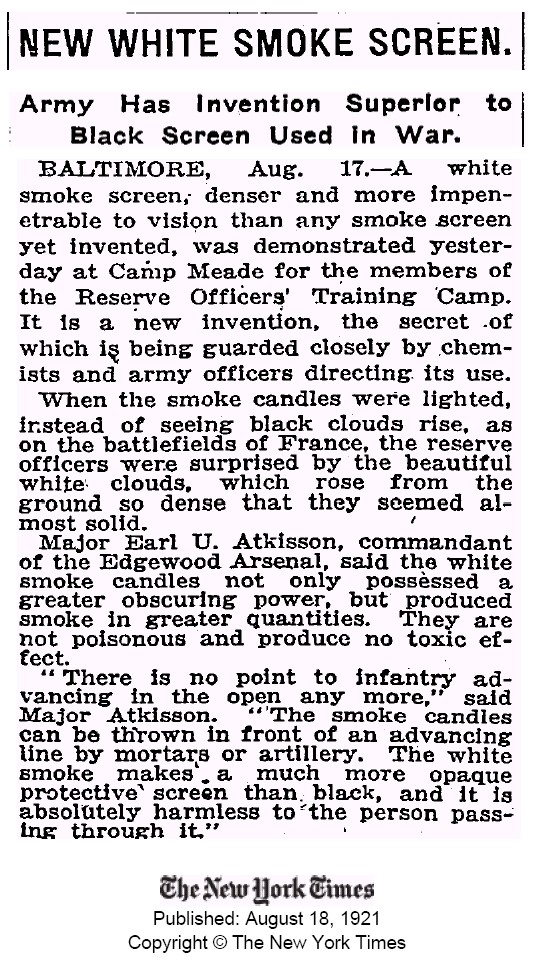
Another method that evolved at this time was the chemical smoke bombs. This method produced by the mixing of chemical compounds. The "smoke" produced was therefore not a smoke at all--not being the product of combustion--but was instead a chemical gas. The advantages of this method was that the gas was highly controllable, could be produced in small containers (gas grenades), and could be made heavier than air and thus linger on the ground. Also, some of these gasses especially due to their heavier than air properties could form a thicker screen than the combustion methods. There were several disadvantages to this system, however. First, the chemicals used were generally highly toxic phosphorous compounds, so, like the actual smoke of the other smoke screen methods, this gas was neither useful to advancing troops nor naval vessels. Secondly, the gas could not be produced in mass quantities due to the expense of chemicals involved and was thus generally only usable in small strike operations.
Post-WWI to Pre-WWII
Sometime shortly after WWI, during the prohibition days, a rum runner, and WWI veteran, named Alonzo Patterson developed an entirely new method superior to all previous ones, but it remained unknown to the military until the years just prior to the U.S. involvement in WWII. His invention was to become the first effective large area smoke screen in the history of warfare, and every military smoke screen technology from WWII to the present day would be firmly based on his revolutionary methods. WWII. Before the military's discovery of the Patterson methods, early WWII inventions were mere improvements on the smudge pot systems and the chemical smoke screen methods.
Near the end of WWI to the beginning of WWII, leaders of the world's armies employed their greatest minds in to develop new and better methods of making smoke. In fact, the United States employed Thomas Edison as head of the U.S. Navy consulting Board during WWI to, among other things, create an effective smoke machine. Later, the Office of Scientific Research and Deveolopment (OSRD) was formed, and one of its first projects was to discover an effective large area smoke screen.
The early research of these organization was on technologies based on the smudge pot and the chemical smoke bomb methods. Numerous improvements were made but even at the start of WWII, they had not been able to discover an effective large area smoke screen. At one point, the OSRD had almost given up on smoke technologies after numerous experiments with oil and chemical generators in Panama. But when the Patterson system was brought to their attention, their interest in smoke screening was quickly rekindled.
Early WWII -- The Patterson System
Alonzo Patterson was, during the prohibition days, a well known and highly successful rum runner given the name "Smoky" by the agents who attempted to chase his fleet of ships while being foiled by his smoke screen. Near the end of Prohibition, Patterson became a Customs Agent and gained several contacts in the government. When U.S. involvement WWII seemed imminent, Patterson's contacts in the government, being highly aware of the effectiveness of his smoke screen, asked him to refine his technology for military use.
To this end, Patterson employed the help of his chemist friend Harold Levy (the chemist who also invented Cellophane, among other significant chemical inventions), to perfect the chemical formulae already developed by Patterson years ago while Patterson worked on refining the apparatuses necessary to the smoke production system. Within a matter of months, the two had refined the smoke screen system used by Patterson during his rum-running days, and the invention was presented to the government during several demonstrations, some of which were accomplished with the help of Andrew Higgins, a close friend and business associate of Patterson who, during prohibition, had built Patterson's rum running fleet according to Patterson's unique designs.
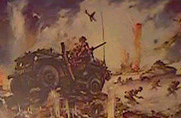
In the end, the Navy and the other branches of the military, found the smoke screen to be highly effective and extremely important to combat. Prior to the Patterson system, military smoke screening was, at best, a minimal factor in combat, but with the Patterson system, military strategy was forever changed by the numerous offensive and defensive advantages created by the first ever effective large area smoke screen.
Wiki adds:
Land fightingA smoke grenade being used during a military training exerciseSmoke screens are usually used by infantry to conceal their movement in areas of exposure to enemy fire. They can also be used by armoured fighting vehicles, such as tanks, to conceal a withdrawal. They have regularly been used since earliest times to disorientate or drive off attackers.
For the crossing of the Dnieper river in October 1943, the Red Army laid a smoke screen 30 kilometres (18 miles) long. At the Anzio beachhead in 1944, U.S. Chemical Corps troops maintained a 25 km (15 mile) "light haze" smokescreen around the harbour throughout daylight hours, for two months. The density of this screen was adjusted to be sufficient to prevent observation by German forward observers in the surrounding hills, yet not inhibit port operations.
In the Vietnam War "Smoke Ships" were introduced as part of a new Air Mobile Concept to protect crew and man on the ground from small arms fire. In 1964-65, the "Smoke Ship" was first employed by the 145th CAB using UH-1B.[1]
Naval warfare
There are a number of early examples of using incendiary weapons at sea, such as Greek fire, stinkpots, fire ships, and incendiaries on the decks of turtle ships, which also had the effect of creating smoke. The naval smoke screen is often said to have been proposed by Sir Thomas Cochrane in 1812, although Sir Cochrane's proposal was as much an asphyxiant as an obscurant. It is not until the early twentieth century that we get clear evidence of deliberate use of large scale naval smokescreens as a major tactic.
Smoke screens were used during the Battle of Jutland in World War I.
In the Battle of the River Plate in World War II, the German pocket battleship Admiral Graf Spee used a smoke screen to escape from the British cruisers.
In the Second Battle of the Atlantic in World War II, smoke screens were used by Allied destroyer escorts to mask the presence of the merchant ships from German U-boats.
At the Battle off Samar in October 1944, Taffy Three, the American Escort Carrier task unit, the escorts laid a smoke screen to allow the carriers to escape, and add to the general confusion.
http://74.125.95.132/search?q=cache:CinXmLDb9vMJ:www.wwiismokescreen.com/My_Homepage_Files/Page1.html+wwwiismokescreen+patterson&hl=en&ct=clnk&cd=2&gl=us
Vapor, not SmokeThe "smoke" created by this technology was neither a smoke (like the product of the combustion smoke screen methods) nor a chemical gas (like the product of the chemical smoke bombs) but was a vapor of a specially designed formula created by Patterson. This formula was referred to as the Patterson secret formula by the military researchers, but shortly after its implementation, the composition was known as "fog oil," a name that had not entered the lexicon until Patterson's invention.
The "fog oil" was atomized by specially designed nozzles, injected into a heated chamber, then vaporized, but not burnt, by the hot gasses within. This vaporized fog oil was then ejected into the air by rapidly moving air flow. Upon entering the air outside the heated chamber, the fog oil vapor immediately condensed, forming an extremely thick fog layer that hung close to the ground. According to one of the Patterson patents, and this was confirmed by subsequent Navy researchers as reported in this document, "...[the] smoke screen or cloud produced...develops a density and opacity greater than the heaviest known natural fog." A person need only imagine the thickest fog they have seen or heard about to realize the enormous obscuring power of this smoke screen. Objects less than 1 foot within the smoke scren were completely hidden from view. It was denser and could be produced faster than any smokescreen ever created.
Troop Health
The Patterson smoke screen system had another great advantage over all previous smokescreens: it was virtually harmless to troops. It had no known short or medium term toxicity. Long term toxicity may have been possible, most likely only with frequent exposure, but even today, there is no clear evidence of long-term side effects resulting from exposure to this type of smoke screen. This is why the main ingredients of the formula remained a part of fog oil compositions long after WWII.
Patterson Obscurant ("Smoke Screen") System
There were several aspects to the Patterson system, all of which were detailed in his four U.S. patents. First was the fog oil formula which was comprised of three primary components: an oil base, an inorganic mineral salt, and a viscosity inducing agent. To this basic formula were added pigments designed to either whiten the smoke (as would a pigment such as Titanium Dioxide) or color the smoke. In addition graphite was often added to prevent valve clogging. (This graphite was later found to be an effective obscurant against infrared). The Patterson formula (perfected with the help of Harold Levy, a chemist) allowed for many different types of permutations of the basic composition described above. All was detailed in his patents on chemical composition of smoke screen and methods of producing smoke screen. All patents following his--continuing to the present day--use one or more of the various Patterson formulae detailed in his patents.
Secondly, were the apparatuses involved. There were two types of apparatuses perfected by Patterson, but each performed the same basic task, to provide a heated chamber for the vaporizing of fog oil and to provide a means of rapid ejection of the vapor into the atmosphere. One apparatus, the mechanical smoke generator used the exhaust of an internal combustion engine as a heating chamber where atomized fog oil would be injected into for vaporization. The ejection of the vapor was accomplished by the movement of hot exhaust through the air chamber. The hot exhaust gasses, therefore, accomplished two purposes. Click here to see pictures and technical drawings of the external combustion engine device. The exhaust type devices would eventually become he preferred design and would be used to this day.
The other Patterson apparatus was a furnace smoke generator, often referred to as a smoke cannon due to its cannon like appearance. In the furnace design, or smoke cannon, fog oil was fed into an elongated tube (the "cannon") and was vaporized by heat generated by propane or other hot gases. The elongated tube accomplished the same purpose as the exhaust manifold (heating chamber) of the mechanical generator. Rapid ejection of gasses out of the tube was aided by air induction ports connected either to a compressor, or to a compressed air tank. Using a compressor required some sort of power, and this was accomplished by a smaller combustion engine. A compressed air tank did not require power, but it had only a limited supply of compressed air.
Patterson favored the mechanical generator, and the reason was most likely that it tended to be more efficient, using only one mechanism to both eject vapor and vaporize fog oil. (The principles of this device would later be utilized in 1950s designs using jet engine heat fed into the "smoke cannon" elongated chamber. These simple high output units became standard equipment in the military).
AIR [BORNE] SMOKESCREENS
Ironically, YEARS before WW2 even began, the U.S. Army realized the need for smokescreens and had aircraft fitted to lay them using the Get-It, Drive On (GIDO) principle.
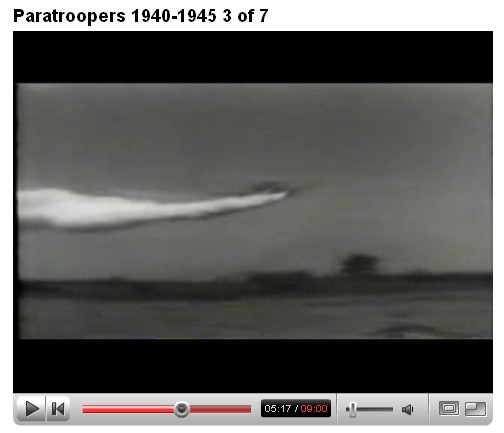
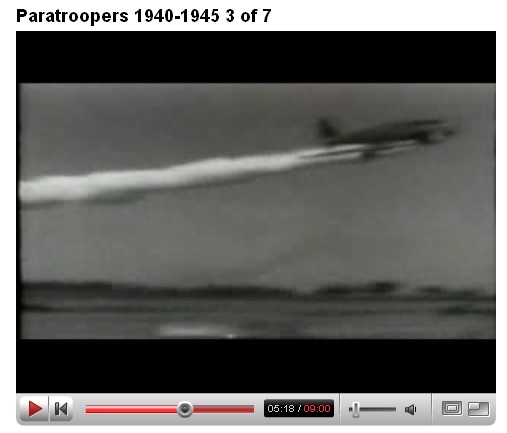

Just months before D-Day, in the Pacific, smokescreens were used for an Airborne forced entry operation at Nadzab, New Guinea, and again the troops landed without being hit by enemy optically aimed gunfire.
Nadzab airfield, New Guinea. 1943.
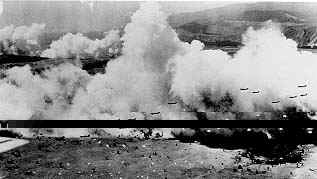
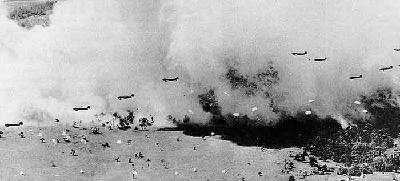
Airlift historian and USAF C-130 Vietnam combat veteran, Sam McGowan writes:
"...the Airborne assault on Nadzab, an airstrip in the Markham Valley in Papau New Guinea in the fall of 1943. If there is a single World War II battle that deserves to be studied by modern advocates of Airborne and Airland operations, Nadzab is it.The attack on Nadzab was planned and executed by the air staff of the Fifth Air Force, the air element of the Southwestern Pacific Command of General Douglas MacArthur. Lt. Gen. George C. Kenney, the Fifth Air Force commander, conceived the attack as a means of catching the Japanese forces at Lae in a pinch between Airborne and Airlifted troops attacking from the northwest and infantry attacking up along the Huon Peninsula (sometimes called the Lae Peninsula) from the southeast. Nadzab was the fruition of a plan Kenney conceived in early 1943 after American and Australian troops, many of whom had been airlifted across the Owen Stanley Mountains, defeated the Japanese force at Buna, a village southeast of Lae. Kenney conceived an Airborne attack at a time when he had no Airborne forces at his disposal. During a visit to the United States in the spring of 1943 Kenney requested the assignment of an Airborne Division to his command. Instead of a Division he got a Regiment, the 503rd Parachute Infantry (the 11th Airborne Division arrived in the Pacific in time for the invasion of the Philippines.)
During the interim prior to the arrival of the first American Paratroops in the Southwest Pacific, Kenney ordered the construction of a secret advanced airfield on the north slopes of the Owen Stanleys less than a hundred miles south of Lae. The new field, at a village known as Tsili-Tsili (and pronounced Silly-Silly) was constructed entirely by airlift. Engineers and construction materials were flown into an existing strip at Marlinan, about four miles from the new site. (The Marlinan strip was not suitable for use by fighters, but it was suitable for C-47s.) Originally the engineers planned to use jeeps and trailers to transport materials between the two bases, until someone came up with the idea of sawing Army trucks in half and transporting the halves in C-47s, then reassembling them in the field. It was not until the base was ready for fighters that it was detected by the Japanese. An attack caught a formation of C-47s as they were approaching to land. At least one transport was shot-down before U.S. fighters broke up the attack.
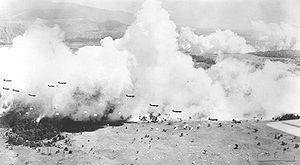
The Nadzab attack was planned as a two-fold operation. American Paratroops airlifted from Port Moresby would jump onto an existing, but lightly defended, airstrip and secure the field while the C-47s returned to Marlinan to pick up/airland Australian infantry who had been pre-positioned there by airlift in anticipation of the operation.
On the morning of the attack the drop formation of some 90 x C-47s from the 374th, 317th and 375th Troop Carrier Groups took off from Seven Mile Aerodrome at Port Moresby and assembled over the field. While the C-47s were assembling into drop formation, then heading out for the drop zone at Nadzab three groups of powerfully armed B-25 strafers were taking off from other airfields in the area. Though factory produced versions of the B-25 gunships would later serve in the Pacific, the airplanes at Nadzab were mostly conventional B-25 medium bombers that had been converted in the field into forward-firing gunships. The bombardier's position was removed from the airplane and the nose was filled with a battery of eight x .50-caliber heavy machineguns while additional guns were installed in pods mounted on the sides and bottom of the bombers, giving each B-25 a battery of 12-14 x .50-caliber heavy machineguns firing forward along the longitudional axis of the airplane. In addition to the heavy machineguns, each B-25 carried a bomb-bay full of small parachute-fragmentation bombs, bombs that floated to earth beneath parachutes to detonate right above the ground, spraying fragments in every direction.
Minutes before the C-47s arrived over the Nadzab drop zone, a very large force (as many as 90 ships) of B-25 gunships hit the airfield. After strafing the drop zone, the B-25s dropped their loads of parafrag bombs. As the last B-25 left the field a flight of A-20s came over and dispensed a cloud of smoke around the DZ to conceal the troopers from the enemy postions in the trees. Above the airstrip a flight of three VIP-carrying B-17s observed the operation. General Kenney was in one airplane, General Douglas MacArthur (who was erroneously referred to by some of his men as 'Dougout Dug') was in another. A fighter cover of P-38s and P-39s kept the Japanese fighters at bay.
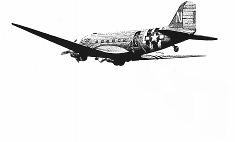
The Paratroopers landed under the concealment of the smoke without taking a single casualty from enemy fire. Within minutes after they were on the ground, the Japanese on the airfield surrendered with very little resistance. The Paratroops hurriedly secured the airfield perimeter and prepared the airstrip for the arrival of troop-carrying C-47s that began arriving in the afternoon. As the C-47s arrived, the Australian infantry assembled and, along with the American Paratroops, began attacking toward Lae.
Now that, folks, is how an Airborne operation is supposed to work, as conceived by General Billy Mitchell and further developed in the minds of men like Kenney, who had served as an observer in Europe in 1940. The Airborne attack was swift and sure, and it followed behind a massive aerial attack by heavily armed fixed-wing gunships who literally swept the area with heavy machinegun fire. The Allies had previously achieved aerial superiority, the gunships suppressed the fire of the Japanese troops who were in the vicinity of the previously determined-to-be lightly defended area and the troops jumped onto a DZ where they met little resistance."
More Details: www.ibiblio.org/hyperwar/USA/USA-P-Rabaul/USA-P-Rabaul-11.html; "Nadzab: The Airborne Invasion"
The threat to U.S. forced-entry operations from dispersed enemy troops has only increased with the advent of man-portable guided missiles. Current U.S. precision-guided weaponry is geared towards destroying high-value point targets or enemy vehicles, not numerous dispersed enemy light infantry. What is needed is a large area effect that can be applied to these enemies at the moment our own troops force-an-entry, so they can assemble and push out the enemy and secure the opening for our own MANEUVER uses thereafter. That effect is the smokescreen.
D-Day, June 6, 1944 Had SOME B-26 Marauder Smoke Screens--but WHERE?
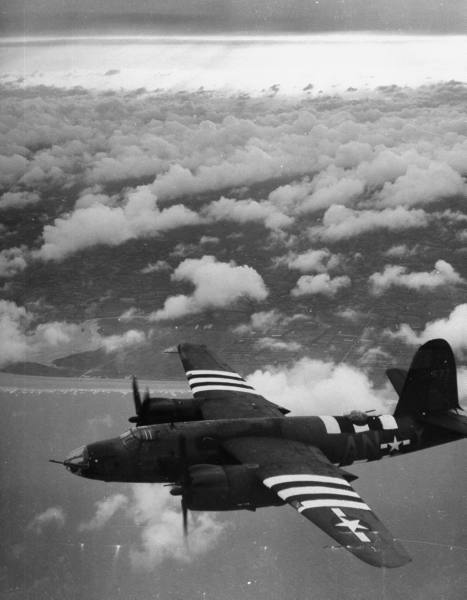


We found this on LIFE magazine google search. Go figure. Why were there not more smoke screens on American beaches on D-Day?
If you find out, email us! itsg@hotmail.com.
Vietnam, 1968: the siege of Khe Sanh by the North Vietnamese Army
While the USMC was only going-through-the-motions of building the so-called "McNamara Line" to fortify the Demilitarized Zone (DMZ) to keep the North Vietnamese from invading the south, firebases were established on key terrain to control infiltration routes like Khe Sanh and Lang Vei. To prevent a repeat of the French defeat at Dien Bien Phu, nearby Hills 881N and 881 South were taken and held after heavy marine corps frontal assaults. Afterwards, marine resupply helicopters were shot down by emplaced NVA air defense artillery, threatening the men from total encirclement and annihilation when their ammo, food and water ran out. Route 9 leading into Khe Sanh was cut and held by the NVA. The few SF advisors and indigenous troops at Lang Vei were over-run by the first NVA use of light tanks in the war. A way had to be found to resupply the Hill ouposts, or Khe Sanh, too would fall like Dien Bien Phu did when the enemy controlled the heights around them and closed down all air resupply. The way was to use the SMOKESCREEN.
Just prior to the vulnerable resupply helicopters flew into the hill outposts, A-4 SkyHawks would drop smoke and CS tear gas bombs on the left and right sides of the planned Landing Zones (LZs) as artillery fire was adjusted onto likely NVA ADA batteries, during this momentary period the enemy was blinded, the helos dropped off their supplies and flew out to safety.
WHAT RIGHT LOOKS LIKE: U.S. Army Helo laying Smoke as Artillery WP Shells Land in Vietnam
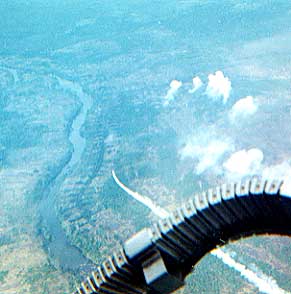
The question is if today we have smoke and tear gas ordnance even available for this kind of use?
The NVA's mortar, rocket and long-range 130mm artillery soon shut down all landings at Khe Sanh. All resupply took place by U.S. Air Force air delivery. After the NVA began to entrench within 100 yards of Khe Sanh, U.S. Air Force B-52s carpet bombed to within 1000 yards of the base and this finally convinced the NVA to withdraw and prevented a replay of Dien Bien Phu. The U.S. Army's Air Cavalry and Armored Cavalry troops then fought their way through to Khe Sanh, opening Route 9 and rescuing the marines trapped there, ending the siege. After this, the marines abandoned Khe Sanh which later became a MIG-21 fighter base for the enemy, as overall U.S. strategy changed after the Tet offensive eliminated U.S. public support for the war, perhaps the first battle employing "4th Generation Warfare" (4GW), actions designed to strike mentally at the will of the people behind the opposing Army.
THE OV-10 BRONCO SMOKESCREEN GENERATOR: WHY WAS THIS NOT FIELDED DURING THE HEIGHT OF THE VIETNAM WAR?
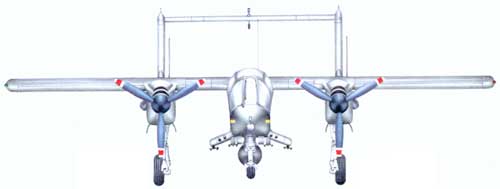
Legendary USMC Colonel KP Rice on his web site www.volanteaircraft.com reveals the OV-10 Bronco had an airborne smoke generating capability that many military clients liked. Why was this not fielded in USMC/USAF/Navy Broncos?
www.volanteaircraft.com/ov-10-9.htm
"...the smoke generator was received enthusiastically by the users - so much so that they wouldn't return the test aircraft for months. None of these items made it into regular use."
www.volanteaircraft.com/ov-10-8.htm
"In addition they demonstrated the capability to lay a tactical smoke screen so successfully that it took much longer than planned to get the demo aircraft back to the States. The users didn't want to let it go. This is a capability that has had great value historically, yet in Vietnam we had no other capability than this OV-10. Jets couldn't get low enough and helicopters were unstable. Today, we have no such capability at all."
An USAF Crew Chief writes:
"Our Broncos at Sembach (20th TASS, 704th TASS) in the 1980s had smoke generators installed. I never saw them used and the reservoirs were not kept filled.
Ask Bronco Association on smoke gen specs, capacity I recall was a couple quarts light 1010 oil. They own a Bronco AND the tech orders and can take pics."
http://www.ov-10bronco.net/
U.S. Army Air Assault Units Used Smokescreens from Smoke Helicopters, Why don't we have any today? WTFO?
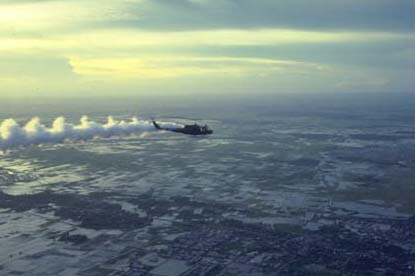
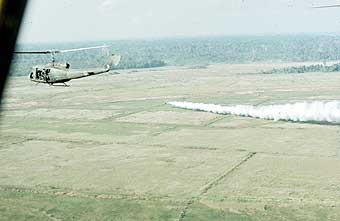
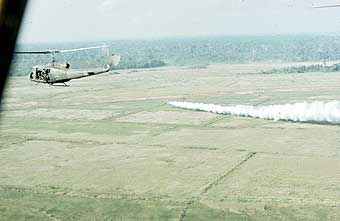
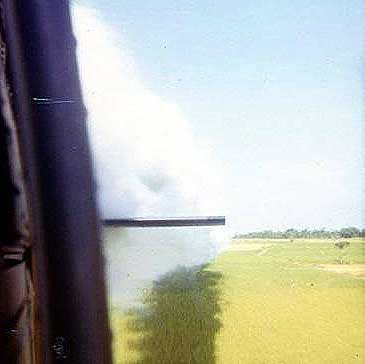
www.118ahc.org/118thAHC.htm
118th Assault Helicopter Company(AHC)
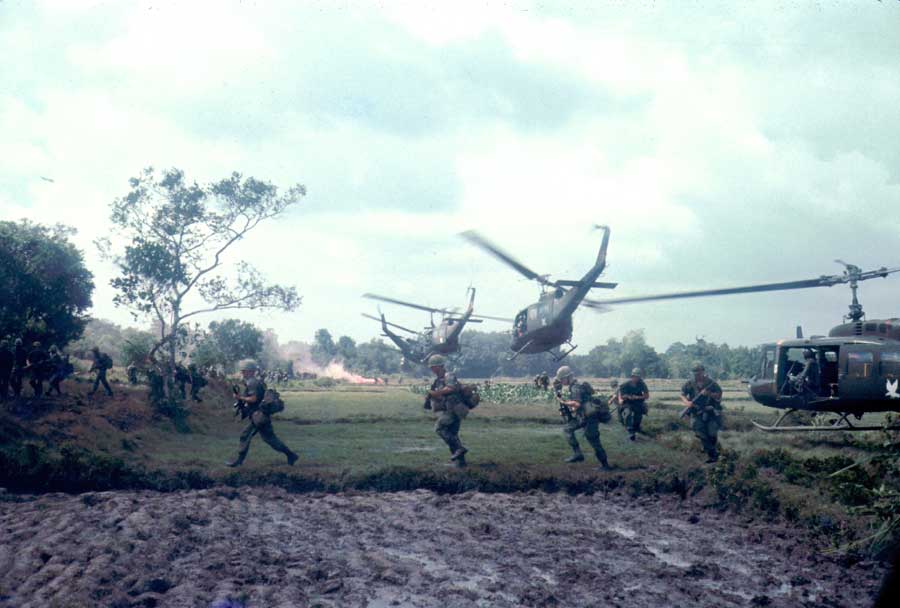
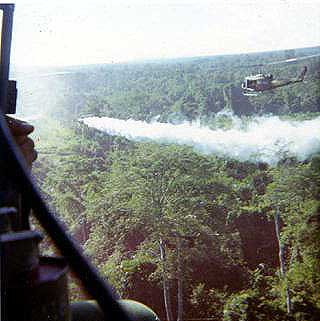
An innovation that came out of the "Air Mobile Concept" in Vietnam was the "Smoke Ship". Spawned by the need to protect the aircraft and crews from Viet Cong small-arms fire, the idea of using smoke to obstruct the vision of the VC gunners as they lay-in-wait was a battle-tried technique dating back to WWI and--perhaps prior.
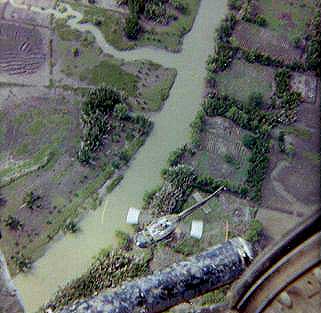
The predominate terrain in the southern provinces of Vietnam and along the sea coasts was open with canals and rice paddies. These terrain features had been "man-made" over hundreds and perhaps thousands of years for transportation and agricultural purposes. They afforded the VC with ready-made dikes and tree lines in which to remain hidden from observation. Thus, the simplest way to foil their effective fire was to obstruct their vision.
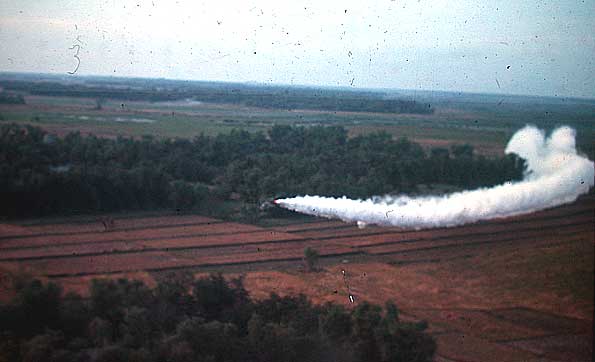
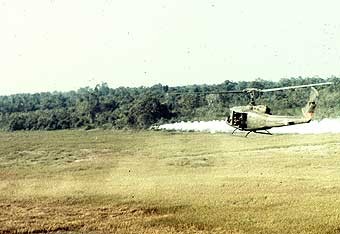
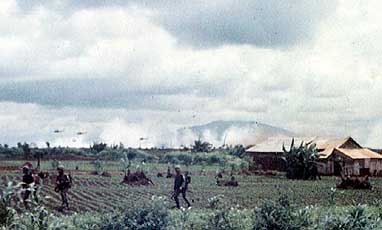
Sometime in 1964-65, the "Smoke Ship" was first employed by the 145th CAB; the first CAB to fly smoke ship missions in Vietnam. In 1966, the 145th CAB "Pathfinder" detachment flew and maintained the UH-1B "Smoke Ship". In 1966 it was usually flown by the Pathfinder Detachment CO, CPT Homer Hudson. Other 145th CAB officers were co-pilots for the craft.
"POLLUTION IV"
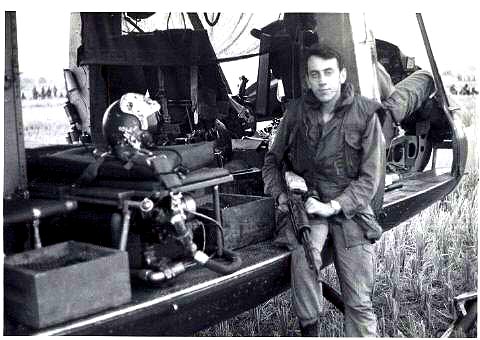
In 1968, the 118th Assault Helicopter Company was able to acquire an extra UH-1H for the use as a "Smoke Ship". Adding tanks to the cargo area and pumps to transfer the "fuel" to the ring of nozzles encircling the turbine exhaust, the "Smoke Ship" and its dedicated crew carried out low-level missions designed to obstruct the vision of the VC anytime a Platoon or Company sized flight was used to insert or extract combat troops. The crew of the "Smoke Ship" was highly dedicated and could be classed as definitely "daredevil" like.
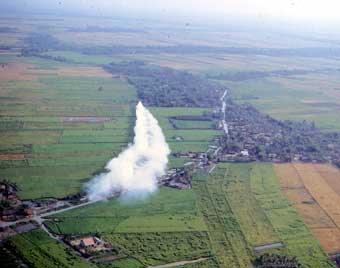
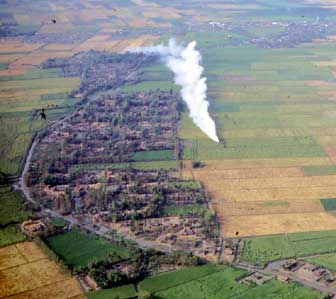
Leading the flight of troop carriers by a minute or so, smoke ship would swoop down to low level, on top of the rice paddies, and fly parallel to the tree line, Nippa Palm line or dike line trailing a dense wall of white puffy smoke. The flight of troop carriers would then land with the smoke providing a "wall" of smoke between them and the suspected VC.
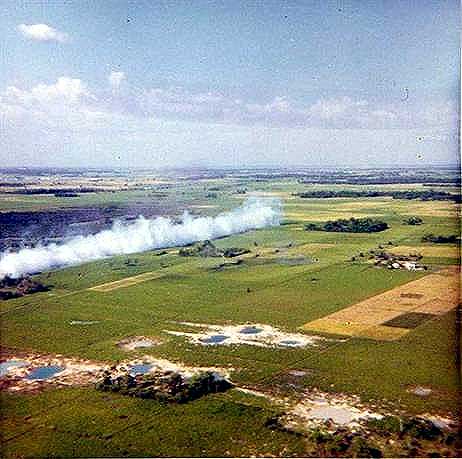
Assuming the wind was not too high, the technique was very effective and the smoke stayed close to the ground for 4-5 minutes. But, the maneuver was highly dangerous for the crews of the "Smoke Ship". However, the very aggressive crew of the smoke ship thrived on it, to hear them tell it!

Interesting photo of combat assault by 118th using a smoke ship in the area of Xuan Loc. Photo provided by John Peeff who was an Advisor with the 18th ARVN Div. (68)
WAR IS TECHNOLOGICAL 1: Head-in-the-Game Results in COMPETENCE
"In April 1968, when I made PIC [pilot-in-command], I was honored, along with another WO in the 1st Platoon with the assignment of one of the first 2 H-models to arrive in the company. That day I got to paint it with a red strip and big white 7 at the base of the vertical fin. (SP5 Bruce Plumb contends that the first H-model was his ship, Red 2) By summer I was asked to 'volunteer' to fly Pollution IV for First Platoon which was one of the next 4 H models to arrive. Two of these H models were fitted with smoke equipment that worked, their tail numbers were IV and VIII. The Second Platoon flew VIII when 2nd Platoon flew lead and I flew IV when 1st Platoon flew lead. Generally every other day was our 'pigs and rice' missions. One of my three gunners was nicknamed 'Killer' (David Evans) a lad of 130 lbs, about 5'5'' and big glasses. A strange 19 year old, but could place a tracer round in the top of a palm tree or the center of a bomb crater puddle from 2000'. I won money on him doing that several times. He could fix any M-60 [medium machine gun] problem that came up and I saw him drop several VC coming out of a tree line on a smoke run. No nude pictures on his wall--just guns and ammo pictures.
WO1 John Robert Wrinkle, 118th AHC from 15 Feb 1968 to 12 Feb 1969
Bob Wrinkle
LTC,USA (Ret)
WAR IS TECHNOLOGICAL 2: FIDO Supply You-Can't-Have-It-Bullshit vs. GIDO Adults Demanding they Get what they Need to Win
A 118th pilot, Robert Konopka, remembers
"The way that pollution IV got the 50 cal. [heavy machine gun] was CPT Chapman, XO of the Thunderbirds, asked me to see if I could 'acquire' a 50 cal. that would be mounted on the smoke ship. He had tried to have supply requisition one through the supply channels with no luck since we were not authorized one. I got busy and traded a couple of VC flags for a couple of air-conditioners which where then traded for a 50 cal. machine gun. You should have seen the XO's eyes when I came walking into the HQ with a 50 cal. over my shoulder. It worked quite well on Pollution IV and was very effective on bunkers and sampans."
GROUND SMOKESCREENS
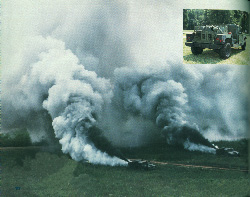

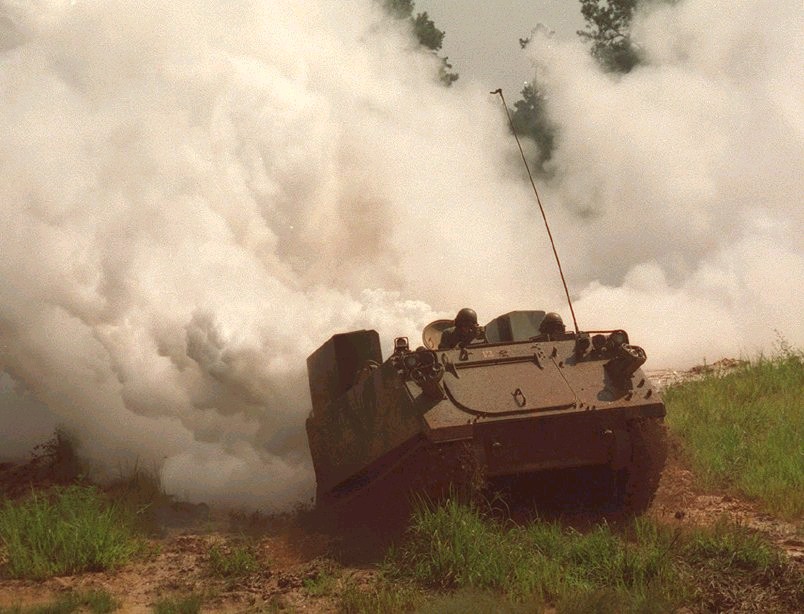
The U.S. Army has long appreciated the value of smoke screens for 2D ground operations by having M113A3 Gavin armored fighting vehicles (M58 "Wolf") and (M56 "Coyote") HMMWVs fitted with smoke generators to mask large formations of vehicles/troops on the move. Work is underway to give the M1 Abrams a smoke screen capability by adding JP-8/diesel directly to the engine exhaust. Field Artillery can lay smoke screens with shells if they have the logistics to deliver the extra smoke shells, HE shells are always first priority. Every AFV has emergency smoke grenades that can be launched to evade a missile attack. The BFV can lay engine smoke.
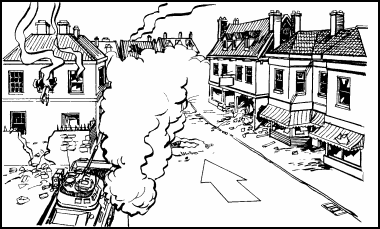
We quote from the book:
"(3) Use of Smoke. The BFVs' engine exhaust smoke system can be used in urban areas to cover the movement of Infantry. The BFV can also provide a smoke screen by using its smoke grenade launchers. This requires careful analysis of wind conditions to ensure that the smoke does not affect friendly units. This is a difficult task since wind currents tend to be erratic between buildings. The smoke can also screen the movements of the BFVs after the Infantry moves (Figure C-14).
NOTE: On-board smoke only works when the vehicle is using diesel fuel. It will not work with JP-8 fuel".
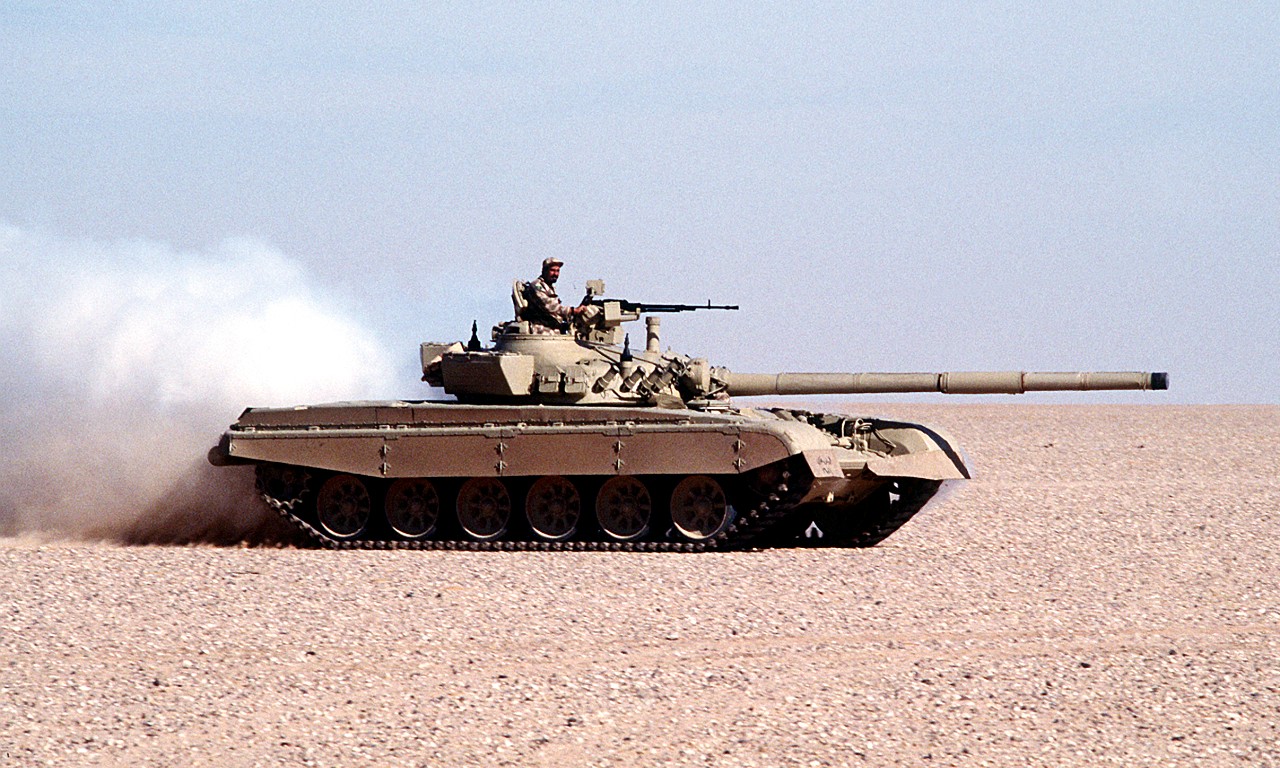
ALL Russian-made tanks have engine smoke capability.
www.inetres.com/gp/military/cv/tank/T-72.html
The T72 medium tank has a "Vehicle engine exhaust smoke system" for persistent smokescreens in addition to emergency anti-ATGM smoke screen defense against ATGMs. Lead tanks can lay smoke to the flanks of the main body to protect them.
However, where are the smokescreens if your smoke grenade launchers are broken and not loaded with smoke grenades? Below is a picture of a M113A3 Gavin light tracked armored fighting vehicle on point in Irag with its right smoke grenade launcher missing! Its left smoke grenade launcher has no smoke grenades in it. This is unsat.
Simple 2.75 inch Hydra-70mm rocket launchers have been easily put on smoke screen-laying (M58) M113 Gavins to project a smokescreen into the enemy's face, [USMC really needed this when they tried to bypass Iraq buildings in vulnerable soft-skin wheeled vehicles during 2d Iraq war] but rejected. The brass realized someone smart would then figure out high explosive 2.75 inch rockets could be also fired, giving the underclass Chemical Branch Soldiers a COMBAT capability (and possible starring role in the battle) reserved only for narcissistic infantry/armor Soldiers. We can't have them help out and take our glory! We need to stop this silliness and get 2.75" rocket launchers on top of our chemical unit M58s PRONTO.
NO ROCKETS FOR YOU!
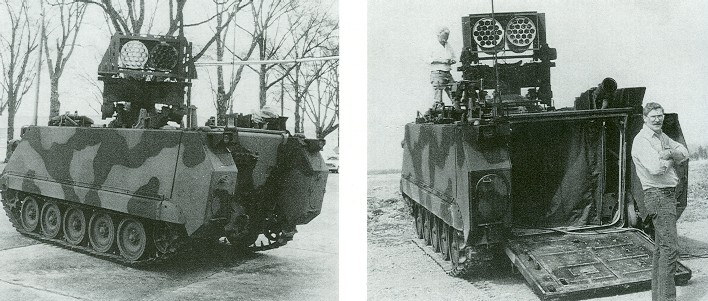
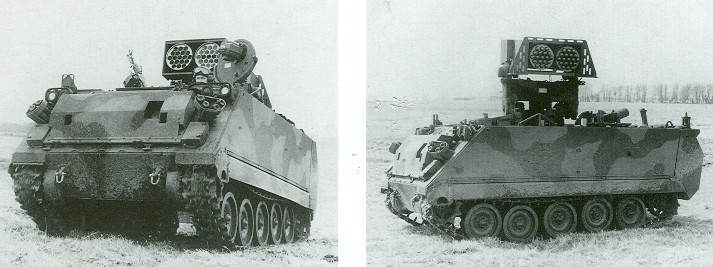
Why don't we use our smoke grenades?
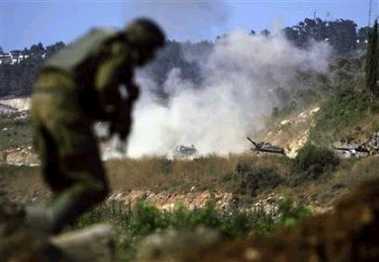
Lazy Americans, NO
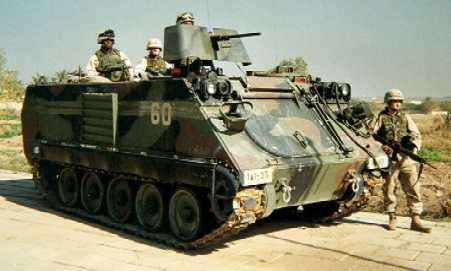
Clearly, every AFV should have hand-tossed smoke grenades that a designated Soldier should toss on direction of his Track Commander to blind the enemy's optically aimed fire as well as mask his vehicle. During Vietnam, smoke grenades were clipped inside gunshields for rapid access.
The M113 Gavin's FM 7-7 FIELD MANUAL No. 7-7 HEADQUARTERS, DEPARTMENT OF THE ARMY Washington, DC, 15 March 1985 THE MECHANIZED INFANTRY PLATOON AND SQUAD (APC) APPENDIX J SMOKE Section I. ONBOARD SMOKE PRODUCERS provides further details:
http://155.217.58.58/cgi-bin/atdl.dll/fm/7-7/Appj.htm
One possible Immediate Action (IA) in event of enemy contact would be to turn the front of the AFV towards the enemy and launch smoke grenades into his face.
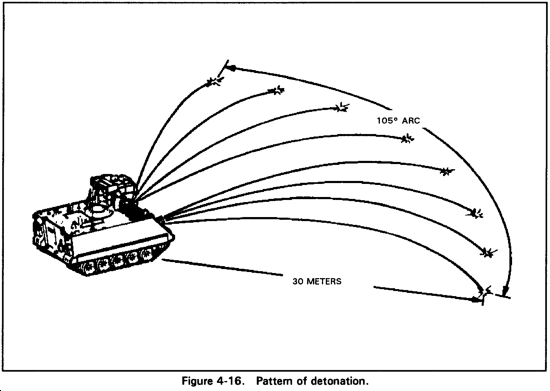
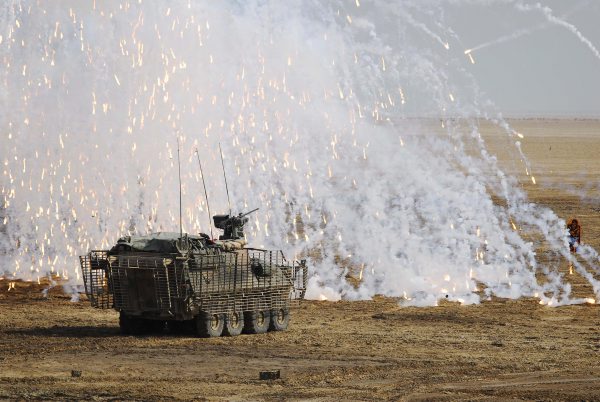
FM 23-34 Chptr 4 M901-Series Improved TOW Vehicle
www.globalsecurity.org/military/library/policy/army/fm/23-34/Ch4.htm
4-16. M243 SMOKE GRENADE LAUNCHER OPERATION The following paragraphs explain how to load, fire, and conduct misfire procedures when using the M243 smoke grenade launcher.
WARNING
1. Do not stand in front of a loaded grenade launcher.
2. Do not place any part of the body in front of the launcher while loading or unloading.
a. Load Grenade Launcher. The gunner places the grenade launcher ARM-OFF switch in the OFF position and ensures the power lamp is not on (Figure 4-15). The loader removes the rubber cover from the tubes and ensures that the tubes are free of foreign objects. The loader inserts a smoke grenade into each tube and pushes down on the grenade's top so that the spring clip at the base of each grenade engages the tip plug at the bottom of each tube. He rotates each grenade about a half turn clockwise to ensure electrical contact.
WARNING
Before firing, make sure no obstacles are directly in front of the vehicle.
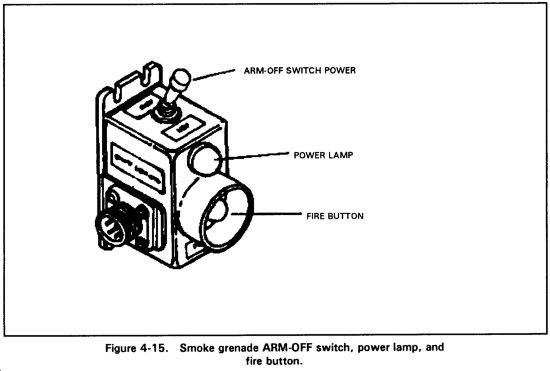
b. Fire the Smoke Grenades. Eight grenades detonate in about a 105-degree arc 30 meters from the vehicle. The smoke cloud is about 9 meters high and lasts about one to three minutes, depending on wind (Figure 4-16). The front of the vehicle is facing the area where the smoke is to conceal the movement of the vehicle. The gunner places the smoke launcher ARM-OFF switch to ARM. He presses the FIRE button when ready to fire.
WARNING
Do not remove misfired grenade under unloading procedures. Use procedures for misfire.
c. Perform Misfire Procedures. If a grenade fails to fire, the gunner makes two more attempts to fire it. If the grenade still does not fire, the gunner ensures that the ARM-OFF switch is OFF and the power lamp is not on. The loader ensures the grenade is firmly seated. If the grenade is not firmly seated, the loader loads it properly. The gunner positions the ARM-OFF switch to ARM and attempts to fire the grenade, If the grenade will not fire when firmly seated, the crew attempts to fire the grenade from another launch tube. If the grenade fires, organizational maintenance is notified of a defective launch tube. If the grenade still does not fire, it is treated as a dud.
WARNING
In a training situation, do not attempt to move a dud grenade. If a grenade fails to ignite after being launched, wait 15 minutes; then notify EOD personnel. Give type, quantity, and precise location of dud.
Why are we not using M243 vehicle smoke grenades to blind enemy ambushes in Iraq?
A veteran armor expert writes:
"I've used this system, it's almost worthless. The fire danger alone to friendly Infantry, and structures, etc. Maybe some wet Jungle? I hit the Tank next to me with one grenade once and burned up everything in the bustle rack and almost destroyed the vehicle and crew. I cannot think of one tactical scenario they were worth the risk."
Vehicle white smoke grenades not red phosphorous
We need plain old fashioned white smoke producing grenades to counter ambushes instead of the incendiary red phosphorous ones we use. Order the LVOSS 66mm grenades for your AFVs instead of the red phosphorous:
M7 Light Vehicle Obscuration Smoke System (LVOSS)
www.fas.org/man/dod-101/sys/land/m7-lvoss.htm
The LVOSS is a self-defense smoke/obscurant device externally mounted on the host vehicle. The LVOSS is made of lightweight materials. The LVOSS has a push button Arming/Firing Unit (A/FU) which allows the operator to select the direction he needs obscured. Additionally, the LVOSS uses smoke grenades which are low in toxicity and which minimize safety hazards to personnel and the environment.
The LVOSS counters threat weapon systems operating in the visual and near infrared portion of the electromagnetic spectrum.
Background/Status:
The LVOSS was Type Classified Standard in August 1997 and production began in FY98.
Characteristics:
Discharger, Grenade, Smoke, Countermeasure, Lightweight, M7
Installation Kit, Grenade Launcher: Smoke, Light Vehicle, 1-M7 Discharger, Turret Mounted, M304
Installation Kit, Grenade Launcher: Smoke, Light Vehicle, 4-M7 Dischargers, Roof Mounted, M305
Installation Kit, Grenade Launcher: Smoke, Up-Armored HMMWV, 4-M7 Dischargers, Roof Mounted, M310
Associated Systems:
Grenade Discharger, Anti-Riot, Irritant, CS, XL96E1
Grenade Discharger, Anti-Riot, Practice, XL97E1
Grenade Launcher: Non-Lethal, Distraction, XM98
Grenade Launcher: Non-Lethal, Blunt Trauma, XM99
Grenade, M90
The Navy's ships can lay smoke screens to defend themselves. At the U.S. Army's Joint Readiness Training Center (JRTC) the OPFOR flies MI-2 Hoplite helicopters that "have a smoke generator mounted to provide a wide area smoke screen in front of PDRA units, screening their movements." We used to be able to lay smoke with UH-1 Huey helicopters, but these are almost all retired now.
Other than this simulated ENEMY USE of Airborne smoke screens, we have no known airborne smoke capability to support 3D maneuvers.
Therefore we have no means to lay a smoke screen during an Airborne or amphibious forced-entry because the "Iowa" Class battleships have been unwisely retired and 5" naval guns do not have the range to reach shore without being themselves sunk, even if they had smoke shells. Close Air Support (CAS) aircraft are best dropping ordnance that kills, though smoke and riot control agent bombs should be fielded or "re-discovered" in our vast stockpiles of ordnance. The best way to generate a lasting smoke screen without need of ordnance is by using a generator carried aloft by a cargo aircraft. And interestingly enough, the USAF and the Army have fielded a trailer mounted A/E32U-13 Multi-Spectral Smoke Generator (MSSG) System for air base defense, which will defeat visual and infared guided weapons.
THE C-130 "SMOKEY BIRDS"
The quickest way to initially test an Airborne smoke capability would be to chain down an Army M56 Coyote smoke generator HMMWV or MSSG trailer to the rear cargo floor of a C-130, open the rear ramp and turn the smoke generator on as the Hercules makes a low pass over the edge of say, Sicily Drop Zone at Fort Bragg, NC. Then, if that works well, get the generators off the cargo bed of the HMMWV or the trailer and onto 463L airlift pallets. If this works well, then to add a fog oil-fuel-IR obscurant holder/pump so these smoke generators can operate for long periods of time for enduring smoke screens to mask large mass tactical airdrops. Anti-ballistic floor panels would be added for crew protection during "Smoky Bird" missions. The crew would wear body armor, also. Smoke capability would be a modular kit capable of being fitted to any C-130 like the MAFFS (Modular Airborne Fire Fighting System) is.
The technique would be for TACAIR--A-10s and/or F-15-16s to drop ordnance (could include smoke bombs, too) to kill any enemy troops threatening the drop zone, followed by at least one C-130 Smokey Bird on each flank of the drop zone laying down a wall of smoke to shield the following airlift aircraft coming in low to drop Paratroopers from small arms and MANPADS (shoulder fired SAMs). The smoke screen would block the enemy from using visual and optical sights to aim small arms and to cue MANPADs. The enemy would not even know when to open fire blindly--if he fires too early, he wastes ammo on nothing, and gives his position away to AC-130 Spectres flying overhead with FLIR that can see through the smoke and blast him with gunnery. Smoke screen use should be SOP for the forced entry operations of the 82nd Airborne Division and its brother separate Regional Airborne Task Forces. Joint operations laying smoke for waterborne forced entries also become a possibility.
NEW MISSION FOR AFSOC: SMOKE OPERATIONS
A Squadron of AFSOC assigned to Pope AFB should be assigned the mission of laying smoke in support of parachute operations. An initial operational capability would be achieved by borrowing smoke generator systems from the Army. Eventually the Smokey Birds should be provided new model "J" propfan C-130s for this mission, since they can fly faster than the current model Hercules and have a smaller crew that would be put at risk for the smoke missions. Small detachments should be assigned to assist the Paratroopers of the 1-501st PIR in the Pacific, and the 1-508th [173rd Airborne Brigade] PIR of SETAF in Europe.
AFSOC should receive the smoke kits and the C-130J Smokey Birds because it would integrate these assets best into both Airborne and Special Operations. Other special missions would be laying smoke over urban areas to mask SOF air/ground vehicles performing missions in these areas.
ARMY-DELIVERED SMOKESCREENS FROM THE AIR: BLACKHAWKS & VIGILANTES
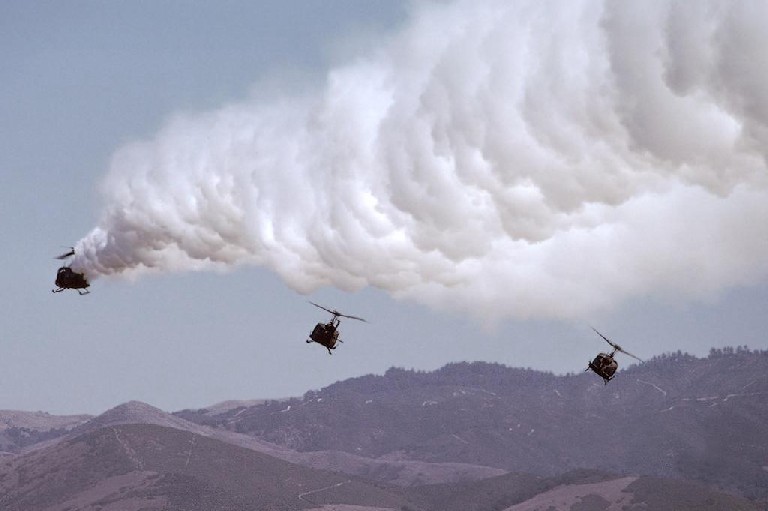
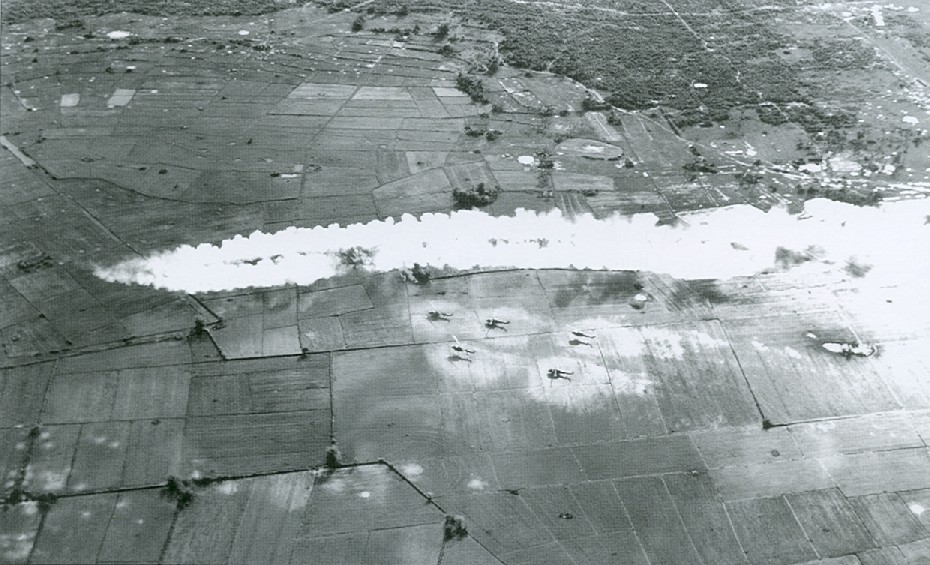
We used to know what RIGHT LOOKED LIKE in terms of helicopter-delivered smokescreens during the Vietnam war. Imagine if we had 1 measly UH-1 Huey lay a smokescreen over the edge of the town of Nasiriyah in 2003 when the wheeled and heavy ground pressure, bloated amtrack marines were trying to bypass.....how many men would be alive today? How many not maimed? How many days of being stopped prevented so the USMC might have gotten to Baghdad on time while the competent and punctual tracked Army 3rd ID waited in West Baghdad, perhaps nabbing Saddam & company?
We damn well better start projecting smokescreens by aircraft and rockets or else the next time we go up against foes with not just RPGs but ATGMs too, from well-camouflaged and dug-in on a ridgeline or city outskirts we are going to get incinerated.
Specially-equipped UH-60L Blackhawk helicopters should also receive modular smokescreen pods attached to their ESSS winglets to support 101st Airborne (Air Assault) operations with masking smoke to prevent "Blackhawk Downs!" (aircraft shoot-downs).
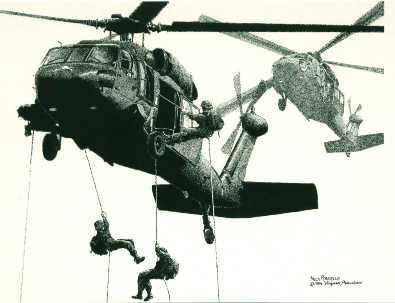
However an even better option would be for the Army to realize helicopters are not maintainable 24/7/365 for continuous air surveillance operations but are best for point-to-point missions exploiting V/STOL. For continuous overhead presence "Maneuver Air Support" we need fixed-wing, two-seat observation/attack aircraft like the OV-1 Mohawk and the Thrush AY-65 Vigilante II. The Vigilante II is amazing because not only does it carry gun, rocket pods it is an armored CROP DUSTER that could LAY DOWN A TACTICAL SMOKESCREEN that could have saved lives during the USMC debacle at Nasiriyah in 2003. The 3rd ID (M) needed armored O/A aircraft during their thunder run into Baghdad as they had to win the battle all by themselves since the marines were bogged down and the Army's helicopters were grounded after the disastrous 11th Aviation Regiment attack on the Medina division.
Smokescreen Aircraft Applications of Fighter-in-a-Box
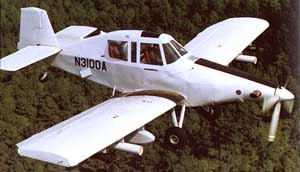

http://youtube.com/watch?v=cbanSkIk-xM
http://youtube.com/watch?v=R9grUNuOgYc
The A-1 SkyRaider fixed-wing attack plane used to have a smokescreen capability that was praised by the marines just before their flyboy egomaniacs retired them. So much for the self-proclaimed practitioners of "close air support". In COunter INsurgency operations a number of writers have cited the leadership and success of using simple fixed-wing aircraft by such legends as General Heinie Aderholdt and Richard Secord in Indo-China and Latin America. One very successful aircraft is the armored Thrush AY-65 crop-duster, which can be armed. These COIN fighters would be simpler than U/MCAVs and have just manned missions to perform; however they would have two: a civilian and a military mission.
Thrush AY-65 V-1-A Vigilante as COIN Aircraft
You may say, "But it's a crop-duster!!"
Yes... but it's much faster than Army helicopters at 200+ mph, its armored, can take a heck of a lot more battle damage than a helicopter, can carry 4,200 lbs of weapons, can stay airborne for 7 hours, and is highly responsive since crop-dusters have to be able to avoid telephone lines and vehicles at the ends of fields when they make their low-level runs. It is also cheap (about $1M each), uncomplicated and easy-to-maintain. Its simply a PT6 turboprop engine on a sturdy monoplane like an AU-27 Caravan except its volume is for liquids not solids and has a fighter-pilot style tandem seating. Like an AU-27 it has civilian applications other than just finding bad guys and killing them; it can crop dust to help grow food to boost the economies of third world countries. It can also fire fight. If there are crops we don't want grown like drug crops we can spray to kill these plants. Narco-Terrorism is a part of 4th Generation Warfare through sub-national groups; the sooner we realize its also a military as well as a police and cultural corruption problem, the better off we will be.
In the 1980s the United States faced a worsening drug problem and adopted a policy of spraying coca plantations in South America and parts of Asia through the U.S. State Department in cooperation with the respective countries' governments. Surplus OV-10 Broncos were modified and used for these roles but the growers threw considerable resources against them, including machine guns, anti-aircraft cannon and even shoulder launched anti-aircraft missiles. It was later realized that the Broncos were vulnerable in the high-threat, low altitude environments they had to operate in. There were also problems integrating the various ducts and spray-bars to the Bronco and the resulting drag compromised performance and degraded handling.
In the interim, the U.S. State Department approached Ayres Corporation of Albany, GA (Now called Thrush Aircraft) to help develop a new "drug eradicator." Ayres specialized in making crop-dusters and owned the rights to the Rockwell Thrush Commander. The resulting aircraft, rolled out in 1983, used an uprated Pratt and Whitney PT6A-65AG turbine engine offering 1,376 hp driving a 9-foot-3-inch five bladed propeller and had an armored two-seat dual control cockpit, an armored back-up fuel tank and provisions for sophisticated communications and navigation equipment. Nine aircraft were delivered to the US State Department inder the designation Turbo-Thrush S2R-T65/5400 NEDS (Narcotics Eradication Delivery System) and were reportedly used in Burma, Thailand, Columbia, Mexico, Guatemala, and Belize.

The U.S. State Department and the U.S. Army Electro-Optical Survivability Program funded development of a modified NEDS for strike duties. The resulting aircraft, dubbed AY-65 V-1-A Vigilante, was identical to the NEDS except that it was equipped to carry weapons instead of spraying equipment. There are 11 hardpoints (four under each wing and three tandem pylons under the fuselage) with a combined ordnance capacity of 4,200 lbs, possible weapon fits including 2.75-in. Hydra 70mm folding-fin aerial rocket pods, napalm canisters, Stinger air-to-air missiles and a variety of bombs. The aircraft can also be fitted with a variety of surveillance equipment including FLIR an LLTV night vision cameras, video recorders and digital data-links for transmitting images to ground stations.
The U.S. Border Patrol successfully tested the Vigilante in the nocturnal border-surveillance role but funding for the aircraft was not available and the program ended.
The NEDS and Vigilante have a maximum speed of 250 mph and an economical cruising speed of 170 mph. Stall speed with flaps extended is 58 mph. With light loads the aircraft can take-off in 395 feet. Fully-loaded it will take off in 1,250 feet.
The Vigilante is said to cost only $1 million each and has an existing worldwide support network, since over 2,500 Thrush crop-dusters have been sold to over 65 countries. An added benefit to using the Vigilante in COIN duties is its low political visibility. It is harder to for the propaganda arm of an insurgent group to demonize before the world press a low-tech modified crop duster than purpose-built military aircraft. The type is also simple enough and may be suited for local production, both for internal security and in the aircraft's primary configuration for agricultural spraying and aerial fire fighting.
COIN Vigilante Main Points
1. Its no problem adding underwing hard points to his aircraft.
2. Thrush just sent an entire crop duster aircraft IN AN ISO CONTAINER to the Far East.
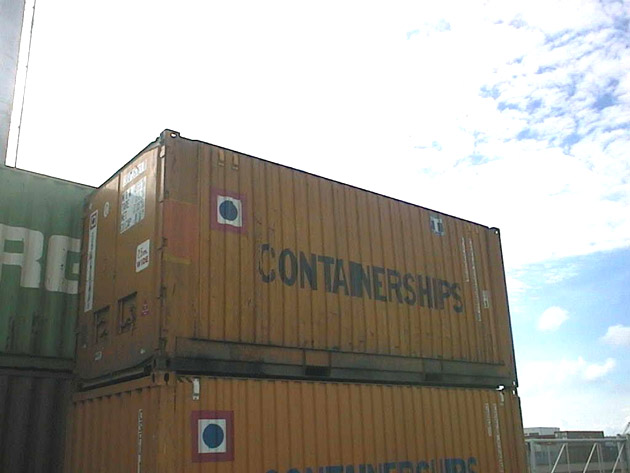
The entire Thrush/AY-65 Vigilante takes 2 days to assemble/disassemble out of a STANDARD ISO CONTAINER. Think about it! An entire COIN Air Force containerized....ship it overseas PROTECTED in ANY container ship. Not this shrink plastic crap we do to Army helicopters, that requires them to be on top decks.
Once overseas, we TRUCK the ISO container Air Force to its forward Operating base (FOB). Unpack the Thrush Vigilante Armored COIN attack plane (2 seats with observer and FLIR) and within 2 days you have an Air Force.
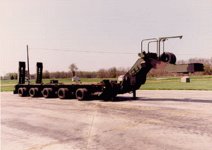
3. Once the aircraft is together the 660 model has pin-on wings that can detach in half a day so the aircraft and its wings can be put on a M1100 trailer (used to transport 12-foot wide M1 tanks. The span of the aircraft's landing gear is 9 feet. We throw a custom cover over the aircraft and if the weather doesn't allow us to fly we can TOW the mini-Air Force to where its next FOB co-located with ground troops are for MAS operations. If the airfield is not made yet, we truck the Vigilantes and have the M113 Gavin bulldozer(s) plow out a 1,000 foot strip and we are in business. Or we can commandeer a stretch of paved highway and bypass civilian traffic.
4. This is DO-ABLE N-O-W without aircraft redesign. I think a mix of these aircraft and multi-sensor COIN aircraft like the OV-1 Mohawk and the vulnerable unarmored, unarmed Iraqi Seeker (keep it away from trouble) as hunters/killer teams would be great for the U.S. Army though we might have to start with the Iraqi and Afghanistan Air Forces first.
http://worldatwar.net/chandelle/v3/v3n3/articles/ayres.html
Combat Crop Dusters: the Turbo-Thrush NEDS and the V-1-A Vigilante
For much of the last quarter century, the United States government has been fighting a secret air war in the jungles of Southeast Asia and in the cloud forests of Central and South America. But in this case, the usual fleet of small, unmarked aircraft are not manned by USAF Special Operations crews or CIA mercenaries, and the enemy is not international communism. Instead the pilots are contractors working for the United States Department of State, and their enemies are plants-specifically, marijuana, opium, and coca. The eradication of these species by aerial application of herbicides has been an ongoing if largely unpublicized feature of American foreign policy since the 1970s. To implement this policy, the United States has deployed a number of specialized, paramilitary aircraft, drawn from military surplus stocks and modified or purpose-built by specialty manufacturers. Among the latter is this month's subject, the Ayres Turbo-Thrush NEDS (Narcotics Eradication Delivery System), a curious hybrid crop duster and counter-insurgency aircraft.
The herbicide campaign got off to a somewhat shaky start in the 1970s. Operation "Ranch Hand," the defoliation of large tracts in Vietnam, was still fresh in the public's memory, and early reports of the toxicity of the chemical used in the operation, Agent Orange, were just starting to come to light. There was thus considerable outcry when it became known that the US had started spraying Mexican and Columbian marijuana with something similar, an allegedly even less safe herbicide called Paraquat. Fears for the health of teenagers who might smoke or consume contaminated marijuana quickly forced a halt to the operation. At roughly the same time, one of the third world's periodic waves of nationalism made it harder for governments in the drug-producing regions to let Yanqui agents and airplanes range freely over their sovereign territory spraying potentially toxic substances that destroyed what were usually traditional, local cash crops. But these reverses were, as it turned out, only temporary.
By the early 1980s, America was discovering cocaine, a South-American alkaloid that had been out of fashion there since the 1920s. The Reagan-era's unbridled admiration for wealth (however obtained), its love of ostentatious luxury, its contempt for government authority, and, above all, its selfishness created an insatiable demand for this drug and for the now-fashionable aura of moneyed decadence and political extremism that had surrounded it since its last vogue. Doctors and mid wives "did" it at suburban cocktail parties. Arbitragers, bankers, and stock brokers did it in executive washrooms. Real estate tycoons did it in their Range Rovers, while their girlfriends did it inside on the dance floors of trendy night clubs. Bartenders, truck drivers, secretaries, and construction workers followed suit as means or credit would allow. The one thing that had ever had any hope of making drug prohibition work in America-the average man's and woman's respect for the law and his or her sense of civic responsibility-was thus swept away in a sort of orgiastic, national binge. Yet, paradoxically, as the will to "just say 'no'" faded and as the compactness of the highly concentrated cocaine powder (at least when compared to bulky bales of cannabis leaf) made traditional enforcement tactics, such as Customs inspections, all but ineffectual, public demands for enforcement, for "action" on the "drug problem," became ever more shrill. Americans, it seems, wanted government that governed them least, but also wanted it to govern someone else more.
It was against this background that the aerial application of herbicides enjoyed something of a renaissance. The Reagan and Bush administrations took our American national weakness-the love of easy answers to complex questions-to extremes in almost every aspect of American life, but in none more so than in drug policy. Spraying was politically attractive because it was a simple, technological fix that did not require any painful, national self-examination. Environmental concerns and the sensitivities of foreigners did not command much sympathy in the electorate at the time, and suitable equipment was available in quantity, due to the Administration's explosive, cost-is-no-object military procurement binge. All kinds of perfectly serviceable, older combat aircraft were now surplus to requirements and on offer to any public agency that would use them. There were more aircraft than takers. Among these were a number of Marine-Corps OV-10D Bronco observation/COIN aircraft. They were fitted with night-vision equipment and had been assigned to the Alcohol, Tobacco, and Firearms division of the Treasury Department. ATF does not seem to have had any clear use in mind for the aircraft, however, and they were soon transferred to the State Department for spraying duties. Possibly, the State Department assumed responsibility for the herbicide mission to lessen the profile of the operation and avoid the provocativeness of a military deployment. Be that as it may, the airplanes were painted black with subdued red trim (as shown on p. 50 of the Squadron-Signal book OV-10 Bronco in Action) and fitted with commercial crop-dusting tankage and windmill-driven sprayers. Then they went into action in South America. While use of the herbicide Spike on coca fields caused some controversy (the substance was alleged to be particularly damaging to the forests of the coca-growing region), the program generally went unnoticed in the US.
The Bronco did not go unnoticed, however, in the mountain valleys of Bolivia, Columbia, Peru, Thailand, and Burma. The growers quickly recognized the threat and threw their considerable resources against the aircraft. Machine guns, automatic antiaircraft cannon, and shoulder-launched missiles were soon being fired against the Broncos, and it quickly became clear that they were not fully up to the job. They had not been designed for a high-threat environment and were known to be vulnerable to IR-guided missiles and light antiaircraft guns, particularly at the suicidally low altitudes necessary for precise spraying. The aircraft's handling had always been tricky, so it was hard to fly close to the ground, under fire, in high-altitude valleys. The commercial windmill, ducts, and spray bars could not be well integrated with a high-wing, three-pod airframe. The needless extra drag of the resulting, compromise arrangement must have seriously hurt performance and further degraded the aircraft's handling. It was clearly only a matter of time before a Bronco would be lost. After at least one aircraft had a canopy shot out during a low-level run, State apparently enquired into the possibility of up-armoring the aircraft. But the real solution was a new airplane, something better suited to the peculiar operating environment of a drug-eradication aircraft.
The State Department had, in the interim, approached the Ayres Corporation of Albany, GA about the possibility of developing a better drug-eradicator. Ayres specialized in crop-dusters, agricultural airplanes designed for low-level spraying operations. It owned the rights to Rockwell's Thrush Commander and had recently replaced the type's piston engine with a more powerful and reliable Pratt & Whitney Canada PT6A turboprop. This aircraft had been designed to carry spray bars, tanks, and windmill pumps like those fitted to the Bronco. It had a 400-gal, 53-cubic-foot fiberglass chemical tank in the fuselage, a fire-extinguishing system, and provision for a second cockpit. In addition, it was designed for hazardous, low-altitude flight. It handled well and was highly responsive, so that pilots could pull up sharply to avoid telephone wires and traffic along the roads that bordered many farmers' fields. It had a crash cage for the pilot, cable cutters, and a high-mounted cockpit canopy with big, flat-plate windows for clear visibility. The turbine's exhaust was fortuitously shielded by the low-mounted wing, lessening the danger from missiles. Perhaps most importantly, the basic crop duster was a low-visibility airplane politically. Agricultural aircraft are common world-wide, so they are far less likely to draw unwelcome attention and less likely to provoke protests than otherwise equivalent military aircraft.
The standard Thrush could hardly stand up to much ground fire, however, sturdy though it might be. Modifications were clearly in order. The aircraft that emerged from the Ayres shop in 1983, the Turbo-Thrush S2R-T65/400 NEDS (Narcotics Eradication Delivery System) had an uprated PT6A-65AG turbine offering 1,376 hp, twice as much as the most powerful standard model. This drove a 9-ft 3-in five-bladed propeller. The extra power made major survivability improvements possible. The engine, a 20-gal fuselage fuel tank, and the two-seat, dual-control cockpit were armored. If a hit incapacitated either crewman, the other was expected to be able to fly home. If hits emptied the standard, Turbo-Thrush wing tanks, the armored fuselage tank would hold enough fuel to get the aircraft back to base. If the aircraft should go down, the rugged crop-dusting structure and armored fuselage would let the crew survive all but the worst crash. King VLF Omega 660, ADF, and VOR navigational equipment plus HF and VHF radio are standard. GPS equipment can also be fitted. While the basic observability of the aircraft is low (as anyone who has seen agricultural aircraft in action can attest), the aircraft can presumably be fitted with the IR- and sound-suppression equipment, radar-warning receivers, chaff/flare launchers, IR jammers, and FLIR night-vision equipment available with the Ayres V-1-A (discussed below). Secure voice-transmission and SATCOM equipment are also likely upgrades.
Nine NEDS airplanes were delivered to the State Department between 1983 and 1985. They are painted black and apparently operate without markings or registration codes of any kind. The 400-gal spray tank is usually filled with Roundup, the Agent Orange component that is still legal in the US for landscaping and forestry uses. Reportedly, the aircraft have been used in Burma, Thailand, Columbia, Mexico, Guatemala, and Belize. In Belize, the NEDS have reportedly been escorted by that country's Britten-Norman Defenders, armed versions of the Islander airliner. These provide covering fire for downed or damaged spray aircraft.
The Ayres V-1-A Vigilante is essentially the NEDS aircraft modified for strike duties. Development was funded by the U.S. Army Electro-Optical Survivability Program and the State Department, so the aircraft may have been intended to give State its own, organic close-support force. The Vigilante is identical to the NEDS except that it is equipped to carry weapons rather than spraying equipment. There are four weapons pylons under each wing and three tandem pylons under the fuselage. The innermost pylon on each wing can carry up to 1200 lbs, while the three outer pylons can carry 350 lb each. Possible loads include pods of 70-mm rockets, 7.62-, 12.7-, or 20-mm gun pods, bombs, napalm canisters, and Stinger missiles. A wide range of surveillance equipment has also been tested on the aircraft, including FLIR and LLTV night-vision cameras, and IR linescan, along with video-recorders and data-links for storing and transmitting the imagery.
In 1989, the U.S. Border Patrol tested the Vigilante in the nocturnal border-surveillance role. The experiment was highly successful, but there was no funding available. No other orders seem to have materialized either.
The Ayres Turbo-Thrush S2R-T65/400 NEDS and the V-1-A Vigilante have a maximum speed of about 250 mph and an economical cruising speed around 170 mph. Stalling speed with flaps extended is 58 mph. The wings span 44 ft 5 in, and the fuselage is 33-ft long. Wing area totals 336 sq-ft. Empty weight is about 4900 lbs and maximum takeoff-and-landing weight is 10,500 lbs. STOL performance is impressive. At light loads, the aircraft can take off in as little as 395 ft. Fully loaded, the take-off run is 1250 ft. Using reverse-thrust, the airplanes can land in as little as 500 ft. Range with full internal fuel loads is 1036 mi. If external tanks are carried, range increases to 2015 mi. More importantly, the aircraft can loiter for up to 7 hours flying at a steady 69 mph.
Text and illustrations (c) 1998 by Robert Craig Johnson
www.dslextreme.com/users/surferslim/cropdust.html
A possible Doomsday asymmetric warfare scenario An U.S. State Department "Black Ops" AY-65 Thrush crop-duster counter-insurgency aircraft used in Colombia and Asia to spray and kill coca crops (cocaine) and opium poppy (heroine) remains missing since October 1st while enroute from Colombia to Patrick Air Force Base in Melbourne, Florida. Mrs. Araujo, the former Colombian Culture Minister, and the Colombian Attorney General's wife, was kidnapped on September 24th and found murdered by FARC guerrillas on September 30th, the night before the U.S. State Department aircraft disappeared. The FARC have ties with the IRA and the al Qaeda terrorist groups. The pilot's name has not been released, nor has any other information except that the aircraft was being ferried from Colombia to Florida for maintenance, was fueled for 12 hours flying time (for a 3 1/2 hour flight from Turks and Caicos Islands southeast of the Bahamas) and was last believed to be lost 75 miles SE of Freeport City, Bahamas, about 150 miles east of Boca Raton, Florida. The FBI is calling airports in Mississippi and asking about crop duster aircraft with a similar N-registry number ("containing N90") to a known U.S. State Department AY-65 crop duster aircraft (N3090M) after at least 3 crop duster spraying incidents on the Mississippi river; a tow boat and 17 barges, a civilian pleasure craft, and an U.S. Coast Guard station. U.S. civilian aircraft "N-Registration" number search.
Missing U.S. State Dept. crop duster links: | 1 | 2 | 3 | 4 | 5 | 6 | 7 | 8 | 9 | 10 .
This is an example of asymmetric warfare at its best... using your enemy's own assets against himself to win the war against America, i.e. using the U.S. airlines, using the U.S. mail, using a strain of U.S. anthrax (Ames), and using a U.S. State Department crop duster aircraft to spray weaponized anthrax throughout the United States to infect millions of people, infect millions of livestock, and contaminate U.S. agricultural grain (spraying barges of corn on the Mississippi river) and meat exports, costing the U.S.A. trillions of dollars and perhaps millions of lives. This is malevolent criminal brilliance comparable to using three Boeing 767 jumbo-jet passenger airliners as .3 kiloton cruise missiles to destroy the World Trade Center and the Pentagon.
This crop duster alert is an UNCONFIRMED REPORT ONLY and is based entirely on uninformed speculation and conjecture from recently reported news events (see links on this page). Missing U.S. Government State Department crop duster aircraft: We believe a small possibility exists that a U.S. State Department Ayres AY-65 crop duster aircraft (Ayres S2RHG-T65) could have been either stolen or hijacked on Monday October 1, 2001, while enroute from Colombia and the Turks and Caicos Islands southeast of the Bahamas while destined for Patrick Air Force Base in Melbourne (Cocoa Beach), Florida. Coast Guard and Air Force planes were searching an area 50 miles southeast of Freeport City, Bahamas late Monday. Florida state highway 1A1 that passes through Patrick Air Force base has been closed indefinitely. We speculate this aircraft might be responsible for at least 1 of the 2 spraying incidents reported on the Mississippi river: The spraying of at least 17 river barges possibly carrying livestock feed grain destined for New Orleans for export, or the spraying of a U.S. Coast Guard Station on the Mississippi river. The aircraft, possibly of registry containing "N90" or a registry number close to this number, is used by the State Department of the United States against drug trafficking to destroy drug crops of opium, marijuana, and coca in Asia (possibly Afghanistan), Mexico, Latin America, and South America. The aircraft color may be either white or black (a white colored aircraft was reported in one incident in Mississippi), as both white and black color schemes are used by the State Department on this aircraft. The black color scheme has no registry number or a very subdued registry number. The aircraft utilizes two sprinkling systems: one for the use of aerosols and liquid particles and another for dropping solid particles. A smoke generator is thought to be installed aboard this aircraft. Crop-dusters often use smoke to mark locations, judge wind direction or send messages. Smoke generators could also be used to make a defensive smoke screen to hide one's location or to defeat IR (infra-red) or AR (active radar) missiles. Graphite impregnated smoke was used in the Gulf War to take out Baghdad's electrical power supply. The AY-65 aircraft is also thought to be resistant to IR guided anti-aircraft missiles because of engine exhaust placement in relation to wing location, has an onboard fire extinguishing system, has low visual observabilty and low radar signature with possible stealth radar reflective coatings or electronics, has an armored cockpit with duel controls for two pilots, has an armored 20 gallon reserve fuselage fuel tank, and may have other sophisticated anti-aircraft missile countermeasures. Most likely this aircraft would not show up on an AWAC's detection systems or ground based radar, especially if flying at low altitudes in mountainous terrain. Night flying would provide decreased visual detection as well. Possible attack configuration AY-65 loads (not the type of the missing aircraft) include pods of 70-mm rockets, 7.62-, 12.7-, or 20-mm gun pods, bombs, napalm canisters, and Stinger missiles. A sprinkling system and a weapons pod cannot be carried simultaneously, but it is thought that Stinger missiles could be carried with either configuration. A wide range of surveillance equipment has also been tested on the aircraft, including FLIR and LLTV night-vision cameras, and IR linescan, along with video-recorders and satellite data-links. The aircraft can presumably be fitted with IR- and sound suppression equipment, radar warning receivers, chaff/flare launchers, and IR jammers and in fact may be. The AY-65 has been used very successfully for nocturnal border surveillance by the U.S. Border Patrol on the Mexico border (1989 test, no further funding). The AY-65 has approximately a 250 to 300 mph top speed (approximately 170 cruise), an uprated PT6A-65AG gas turbine offering 1,376 hp, an empty weight of about 4900 lbs and a maximum takeoff-and-landing weight of 10,500 lbs. with impressive STOL performance, an 1036 mile range (2015 miles with external tanks), engine sound suppression, and up to a 16 hour loiter time at 69 mph (stall is 58 mph). We believe this aircraft could be destined for the west coast of the United States, most probably Houston, San Antonio, Phoenix, San Diego, and Los Angeles. Refueling stops (2 to 5) would most likely be made in Mexico. The possibility also exists this aircraft is flying north up the Mississippi river valley to population centers such as St. Louis, Memphis, and Chicago. This aircraft should be considered to be a weapon of mass destruction as it could likely be loaded with 400 gallons of weaponized anthrax in saline solution. This is only a warning to be on the look out for such an aircraft flying from Mississippi to Southern California along the Mexico border. We believe a possibility exists that Cuban or Colombian nationals could be involved. A likely last fuel stop before reaching San Diego or Los Angeles could be the remote Jacumba county airport in Jacumba, CA on the Mexico border in eastern San Diego county, but as this aircraft has STOL capability, it can land and take off from virtually anywhere. We continue to believe the United States is under a major biological attack from Usama bin Laden and the al Qaeda terrorist group. Reportedly, this aircraft has been used in Burma, Thailand, Columbia, Mexico, Guatemala, Cuba, and Belize (and a medium probability exists that it was used covertly in Afghanistan to spray opium poppy crops). This crop duster alert is an UNCONFIRMED REPORT ONLY and is based entirely on uninformed speculation and conjecture from recently reported news events (see links on this page).
.................................................... See Combat Crop Dusters for more information about this very unusual aircraft.
Mississippi sprayings are simple misunderstandings says FBI.
U.S. civilian aircraft "N-Registration" number search. Missing U.S. State Dept. crop duster links: | 1 | 2 | 3 | 4 | 5 | 6 | 7 | 8 | 9 | 10 . Return to: U.S. Border Report.
Note: Quality Aerospace acquired the assets of Ayres Aerospace in 2001.
www.ayrescorp.com
Thrush 660
www.thrushaircraft.com/thrush.php?lang=eng&page=5&thrush=3
There are some things we simply can't describe. Only flying the new 660 model Turbo Thrush can adequately describe the sense of control, or the security you will feel. You must be sitting in the cockpit to appreciate the stable flight characteristics and performance of the Thrush.
The new wing with its 54-foot wing span and increased area (400 sq. ft.) ensures unmatched stability and control during ag maneuvers. When it comes to negotiating rough strips, small fields or obstacles, you will never be more comfortable than in a Thrush.
Not only is the Turbo Thrush the world's most rugged ag aircraft, it also has one of the best swath and spray patterns in ag aviation today. The combination of a solid airframe with the economical AlliedSignal or Pratt & Whitney engines creates an aircraft that outperforms the competition.
A wide range of engine and airframe options ensures that the 660 Turbo Thrush is available in a configuration to meet your requirements.
Check out these value-added features:
Rugged Thrush Airframe
New 54-Foot Wing Span & Redesigned Tips
Longer Steel Spar Caps for Added Strength & Longevity
All-New Rugged Steel Spring Landing Gear
660-Gallon Hopper With Three-Inch Spray System
Superior Corrosion Protection
Pressurized Aft Fuselage
Shadin Fuel Flow Indicator & Totalizer Standard
Smoker Drift Detection System
Specifications and Performance Data
• Maximum Take-off Weight 14,150 lbs. 6,148 kg
• Maximum Landing Weight 12,500 lbs. 5,670 kg
• Fuel Capacity 228 Gallons 863 liters
• Hopper Capacity (with Spray System) 710 Gallons 2,687 liters
• Hopper Capacity (with Fire Bomber Installation) 785 Gallons 2,971 liters
• Velocity Never Exceed 220 mph 355 kph
• Sea Level Rate of Climb at 12,500 lbs. 1,025 fpm 312 mpm
• Sea Level Rate of Climb at 14,150 lbs. 700 fpm 213 mpm
• Take-Off Distance @14,150 lbs. 1,100 ft. 355 mtrs.
• Landing Distance (as Usually Landed) 600 ft. 183 mtrs.
• Cruising Speed @ 55% Power 185 mph 298 kph
• Ferry Range @ 50% power 600 miles 966 kilometers
Note: performance based on Pratt & Whitney PT6A-65. Ag specs are subject to change.
www.airpower.maxwell.af.mil/airchronicles /apj/6spr91.html
8. http://216.239.41.104/search?q=cache:ZlfTK64t6MQJ:freerepublic.com/focus/f-news/1050707/posts%3Fpage%3D53+ayres+armored+crop+duster&hl=en&ie=UTF-8
strategypage.com ^ | January 1, 2004 | HTMW Headlines
Posted on 01/02/2004 8:23:34 PM PST by Destro
WARPLANES: Why Afghanistan Still Hasn't Got an Air Force
January 1, 2004: Many reports have come out of Afghanistan on the efforts to rebuild the national army. But nothing has been heard about rebuilding the Afghan air force. That's because there is a struggle going on in the Pentagon between U.S. Air Force officers who want a "proper air force" with jet fighters (the U.S. has a lot of low mileage, slightly used, F-16s available). But others protested that this would take too long and that what the Afghans really needed was a bunch of smaller, slower aircraft that could double as trainers. There are quite a few aircraft like this available, and they are used by many third world countries for border patrol and counter-insurgency. It's easier to train pilots to use them, cheaper to buy them and much less cheaper to operate them. It costs $2,000 per flying hour to operate an F-16, but less than half that for trainer/light attack types. These "trainer/light attack aircraft" can also operate from crude airports, or even a stretch of highway. Aircraft like this can carry system to defeat portable surface to air missiles. They can carry smart bombs as well. But from the U.S. Air Force point of view, there are several problems with these aircraft. First, none of these aircraft are made in the United States, so Congress will not be happy about U.S. tax dollars buying non-American warplanes. Second, the U.S. Air Force has no experience with these aircraft. Finally, the air force doesn't want something like this to succeed in Afghanistan and raise questions about U.S. Air Force tactics and buying decisions. So far, this battle is a stalemate, and the Afghans are left with no air force of their own. But the Afghans could just decide to go form one on their own. For example, Brazil manufactures the Super Tucano, a single engine turbo-prop trainer/attack aircraft that is used over a dozen nations. This aircraft carries two .50 caliber machine-guns and carries 1.5 tons of bombs and rockets. It can stay in the air for 6.5 hours at a time. It is rugged, easy to maintain and cheap ($5 million each, versus over $20 million each for used F-16s.) Afghanistan already has hundreds of pilots who would quickly learn how to handle the Super Tucano. This aircraft could be easily equipped to carry a dozen of the new 250 pound GPS smart bombs (or half a dozen dumb 500 pound bombs), giving it considerable firepower. The Super Tucano already comes equipped with a GPS guidance system. Max altitude is 35,000 feet and cruising speed is 400 kilometers an hour. Naturally, this aircraft can move in lower and slower than any jet can. The Super Tucano is also equipped with armor for the pilot, a pressurized cockpit and an ejection seat. Not bad for an aircraft with a max take off weight of 3.5 tons. Another proposal is to use a "combat crop duster," originally built at the behest of the U.S. State Department to spray drug crops in nations that produce lots of illegal crops. This aircraft, the Turbo-Thrush S2R-T65/5400 NEDS (Narcotics Eradication Delivery System), has armor for the two man crew, can stay in the air for seven hours, a cruising speed of 272 kilometers an hour and a max altitude of 25,000 feet. The five ton aircraft normally carries about two tons of crop dusting chemicals. The manufacturer modified one for combat use, calling it the AYRES V-1-A Vigilante, simply by equipping it with hardware compatible with military bomb racks. The V-1-A can carry two tons of bombs, machine-gun pods, sensors or whatever. No fancy cockpit or ejection seat, but very maneuverable and over 2,500 of the original crop duster version in use world wide. Each ones costs less than two million dollars. While an Afghan Air Force officer could understand the usefulness of the V-1-A or Super Tucano, U.S. Air Force officers cannot. This has been the case since the Vietnam war, when pragmatic air force officers got some prop-driven light bombers into action and demonstrated their obvious superiority over jets in counterinsurgency warfare. While the troops loved this kind of air support, the guys who ran the U.S. Air Force did not, and still don't.
NOTES
http://en.wikipedia.org/wiki/Smoke_screen
Smoke screenFrom Wikipedia, the free encyclopedia
Jump to: navigation, search
For the Transformers character, see Smokescreen (Transformers)
A U.S. Army Humvee laying a smoke screen
A smoke screen is a release of smoke in order to mask the movement or location of military units such as infantry, tanks, aircraft or ships.
It is most commonly deployed in a canister, usually as a grenade. The grenade releases a very dense cloud of smoke designed to fill the surrounding area even in light wind. They have also been used by ships.
Whereas smoke screens would originally have been used to hide movement from enemies' line of sight, modern technology means that they are now also available in new forms; they can screen in the infrared as well as visible spectrum of light to prevent detection by infrared sensors or viewers, and also available for vehicles is a superdense form used to prevent laser beams of enemy target designators or range finders on vehicles.
Contents
1 Technology
1.1 Smoke grenades
1.2 Smoke shell
1.3 Smoke generators
1.4 Naval methods
2 Infrared smokes
3 Chemicals used for smoke generation
3.1 Zinc chloride
3.2 Chlorosulfuric acid
3.3 Titanium tetrachloride
3.4 Phosphorus
3.5 Oil
3.6 Dyes
4 Tactics
4.1 Land fighting
4.2 Notable uses of smoke screens in naval warfare
5 References
6 See also
Technology
Smoke grenades
Main article: Smoke grenade
Smoke grenadeThese are canister-type grenades used as a ground-to-ground or ground-to-air signaling device. The body consists of a steel sheet metal cylinder with a few emission holes on top and on the bottom to allow smoke release when the smoke composition inside the grenade is ignited. In those that produce colored smoke, the filler consists of 250 to 350 grams of colored (red, green, yellow or violet) smoke mixture (mostly potassium chlorate, sodium bicarbonate, lactose and a dye). In those that produce screening smoke, the filler usually consists of HC smoke mixture (hexachloroethane/zinc) or TA smoke mixture (terephthalic acid). Another type of smoke grenades are those which burst. These are filled with white phosphorus (WP), which is spread by explosive action. The phosphorus catches fire in the presence of air, and burns with a brilliant yellow flame, while producing copious amounts of white smoke (phosphorus pentoxide). WP grenades double as incendiary grenades.
Smoke shell
See also Smoke shells.
Artillery and mortars can also fire smoke generating munitions, and are the main means of generating tactical smokescreens on land. As with grenades, artillery shells are available as both emission type smoke shell, and bursting smoke shell. Mortars nearly always use bursting smoke rounds because of the smaller size of mortar bombs and the greater efficiency of bursting rounds.
Smoke generators
Very large or sustained smoke screens are produced by a smoke generator. This is a machine which heats a volatile material (typically oil or an oil-based mixture) to evaporate it, then mixes the vapour with cool external air at a controlled rate so it condenses to a mist with a controlled droplet size. Cruder designs simply boiled waste oil over a heater, while more sophisticated ones sprayed a specially formulated oily composition ("fog oil") through nozzles onto a heated plate. Choice of a suitable oil, and careful control of cooling rate, can produce droplet sizes close to the ideal size for Mie scattering of visible light. This produces a very effective obscuration per weight of material used. This screen can then be sustained as long as the generator is supplied with oil, and-especially if a number of generators are used-the screen can build up to a considerable size. One 50 gallon drum of fog oil can obscure 60 miles of land in 15 minutes.
Whilst producing very large amounts of smoke relatively cheaply, these generators have a number of disadvantages. They are much slower to respond than pyrotechnic sources, and require a valuable piece of equipment to be sited at the point of emission of the smoke. They are also relatively heavy and not readily portable, which is a significant problem if the wind shifts. To overcome this latter problem they may be used in fixed posts widely dispersed over the battlefield, or else mounted on specially adapted vehicles. An example of the latter is the M56 [Humvee] Coyote generator.
Naval methods
Warships have sometimes used a simple variation of the smoke generator, by injecting fuel oil directly into the smoke stack. They also use large floating smoke canisters, known as smoke buoys. In the past they have also used sprays of chemicals that fume on contact with air, such as titanium tetrachloride.
Infrared smokes
The proliferation of thermal imaging FLIR systems on the battlefields necessitates the use of obscurant smokes that are effectively opaque in the infrared part of electromagnetic spectrum. To achieve this, the particle size and composition of the smokes has to be adjusted. One of the approaches is using an aerosol of burning red phosphorus particles and aluminium coated glass fibers; the infrared emissions of such smoke curtains hides the weaker emissions of colder objects behind it, but the effect is only short-lived. Carbon (most often graphite) particles present in the smokes can also serve to absorb the beams of laser designators. Yet another possibility is a water fog sprayed around the vehicle; the presence of large droplets absorbs in infrared band and additionally serves as a countermeasure against radars in 94 GHz band. Other materials used as visible/infrared obscurants are micropulverized flakes of brass or graphite, particles of titanium dioxide, or terephthalic acid.
Older systems for production of infrared smoke work as generators of aerosol of dust with controlled particle size. Most contemporary vehicle-mounted systems use this approach. However the aerosol stays airborne only for a short time.
The brass particles used in some infrared smoke grenades are typically composed of 70% copper and 30% zinc. They are shaped as irregular flakes with a diameter of about 1.7 µm and thickness of 80-320 nm. [1]
A reportedly good improvised system for production of aerosol effective even in far infrared is said to be a dry powder fire extinguisher. [2]
Some experimental obscurants work in both infrared and millimeter wave region. They include carbon fibers, metal coated fibers or glass particles, metal microwires, particles of iron and of suitable polymers. [3]
Chemicals used for smoke generation
Zinc chloride
Zinc chloride smoke is grey-white and consists of tiny particles of zinc chloride. The most common mixture for generating these is the zinc chloride smoke mixture (HC), consisting of hexachloroethane, grained aluminium and zinc oxide. The smoke consists of zinc chloride, zinc oxychlorides, and hydrochloric acid, which absorb the moisture in the air. The smoke also contains traces of organic chlorinated compounds, phosgene, carbon monoxide, and chlorine.
Its toxicity is caused mainly by the content of strongly acidic hydrochloric acid, but also due to thermal effects of reaction of zinc chloride with water. These effects cause lesions of the mucous membranes of the upper airways. Damage of the lower airways can manifest itself later as well, due to fine particles of zinc chloride and traces of phosgene. In high concentrations the smoke can be very dangerous when inhaled. Symptoms include dyspnea, retrosternal pain, hoarseness, stridor, lachrymation, cough, expectoration, and in some cases haemoptysis. Delayed pulmonary edema, cyanosis or bronchopneumonia may develop. The smoke and the spent canisters contain suspected carcinogens.
The prognosis for the casualties depends on the degree of the pulmonary damage. All exposed individuals should be kept under observation for 8 hours. Most affected individuals recover within several days, with some symptoms persisting for up to 1-2 weeks. Severe cases can suffer of reduced pulmonary function for some months, the worst cases developing marked dyspnea and cyanosis leading to death.
Respirators are required for people coming into contact with the zinc chloride smoke.
Chlorosulfuric acid
Chlorosulfuric acid (CSA) is a heavy, strongly acidic liquid. When dispensed in air, it readily absorbs moisture and forms dense white fog of hydrochloric acid and sulfuric acid. In moderate concentrations it is highly irritating to eyes, nose, and skin.
When chlorosulfuric acid comes in contact with water, a strong exothermic reaction scatters the corrosive mixture in all directions. CSA is highly corrosive, so careful handling is required.
Low concentrations cause prickling sensations on the skin, but high concentrations or prolonged exposure to field concentrations can cause severe irritation of the eyes, skin, and respiratory tract, and mild cough and moderate contact dermatitis can result. Liquid CSA causes acid burns of skin and exposure of eyes can lead to severe eye damage.
Affected body parts should be washed with water and then with sodium bicarbonate solution. The burns are then treated like thermal burns. The skin burns heal readily, while cornea burns can result in residual scarring.
Respirators are required for any concentrations sufficient to cause any coughing, irritation of the eyes or prickling of the skin.
Titanium tetrachloride
Titanium tetrachloride (FM) is a yellow, non-flammable, corrosive liquid. In contact with damp air it hydrolyzes readily, resulting in a dense white smoke consisting of droplets of hydrochloric acid and particles of titanium oxychloride.
The titanium tetrachloride smoke is irritant and unpleasant to breathe.
It is dispensed from aircraft to create vertical smoke curtains, and during World War II it was a favorite smoke generation agent on warships.
Goggles or a respirator should be worn when in contact with the smoke, full protective clothing should be worn when handling liquid FM. In direct contact with skin or eyes, liquid FM causes acid burns.
Phosphorus
Main article: White phosphorus (weapon)
Red phosphorus and white phosphorus (WP) are red or waxy yellow or white substances. White phosphorus is pyrophoric - can be handled safely when under water, but in contact with air it spontaneously ignites. It is used as an incendiary. Both types of phosphorus are used for smoke generation, mostly in artillery shells, bombs, and grenades.
White phosphorus smoke is typically very hot and may cause burns on contact. Red phosphorus is less reactive, does not ignite spontaneously, and its smoke does not cause thermal burns - for this reason it is safer to handle, but cannot be used so easily as an incendiary.
Aerosol of burning phosphorus particles is an effective obscurant against thermal imaging systems. However, this effect is only very short-lived, and after the phosphorus particles are fully burned, the smoke reverts from emission to absorption. While very effective in visible spectrum, cool phosphorus smoke has only low absorption and scattering in infrared wavelengths. Additives can be present in the smoke which cover this part of the spectrum. [4]
Oil
Oil smoke is usually produced by smoke generators. The resulting "smoke" is a mist of oil droplets of controlled size, and is therefore technically not smoke but fog. Rather than being produced by the combustion of fog oil, it is produced by heating of fog oil, the release of hot (but not burnt) fog oil into the air, and the condensing of hot fog oil on contact with air.
Particles of graphite can be added to oil mist to make it opaque in infrared spectrum, providing additional degree of protection against thermal imaging and laser designators.
Dyes
Main article: Colored smoke
Various signalling purposes require the use of colored smoke. The smoke created is a fine mist of dye particles, generated by burning a mixture of one or more dyes with a low-temperature pyrotechnic composition, usually based on potassium chlorate and lactose (also known as milk sugar).
Colored smoke screen is also possible by adding a colored dye into the fog oil mixture. Typical white smoke screen uses titanium dioxide (or other white pigment), but other colors are possible by replacing titanium dioxide with another pigment. When the hot fog oil condenses on contact with air, the pigment particles are suspended along with the oil vapor. Early smoke screen experiments attempted the use of colored pigment, but found that titanium dioxide was the most light scattering particle known and therefore best for use in obscuring troops and naval vessels. Colored smoke became primarily used for signaling rather than obscuring. In today's military, smoke grenades are found to be non-cancer causing, unlike the 50's AN-M8 model.
Tactics
Land fighting
A smoke grenade being used during a military training exercise
Smoke screens are usually used by infantry to conceal their movement in areas of exposure to enemy fire. They can also be used by armoured fighting vehicles, such as tanks, to conceal a withdrawal. They have regularly been used since earliest times to disorientate or drive off attackers.
For the crossing of the Dnieper river in October 1943, the Red Army laid a smoke screen 30 kilometres (18 miles) long. At the Anzio beachhead in 1944, U.S. Chemical Corps troops maintained a 25 km (15 mile) "light haze" smokescreen around the harbour throughout daylight hours, for two months. The density of this screen was adjusted to be sufficient to prevent observation by German forward observers in the surrounding hills, yet not inhibit port operations.
In the Vietnam War "Smoke Ships" were introduced as part of a new Air Mobile Concept to protect crew and man on the ground from small arms-fire. In 1964-65, the "Smoke Ship" was first employed by the 145th CAB using UH-1B.[1]
Notable uses of smoke screens in naval warfare
There are a number of early examples of using incendiary weapons at sea, such as Greek fire, stinkpots, fire ships, and incendiaries on the decks of turtle ships, which also had the effect of creating smoke. The naval smoke screen is often said to have been proposed by Sir Thomas Cochrane in 1812, although Sir Cochrane's proposal was as much an asphyxiant as an obscurant. It is not until the early twentieth century that we get clear evidence of deliberate use of large scale naval smokescreens as a major tactic.
Smoke screens were used during the Battle of Jutland in World War I.
In the Battle of the River Plate in World War II, the German pocket battleship Admiral Graf Spee used a smoke screen to escape from the British cruisers.
In the Second Battle of the Atlantic in World War II, smoke screens were used by Allied destroyer escorts to mask the presence of the merchant ships from German U-boats.
At the Battle off Samar in October 1944, Taffy Three, the American Escort Carrier task unit, the escorts laid a smoke screen to allow the carriers to escape, and add to the general confusion.
References
1.^ 118 th AHC
See also
Look up smokescreen in Wiktionary, the free dictionary.
Smoke bomb
PT boat
Early thermal weapons
Retrieved from "http://en.wikipedia.org/wiki/Smoke_screen"
Categories: Weapons countermeasures | Smoke
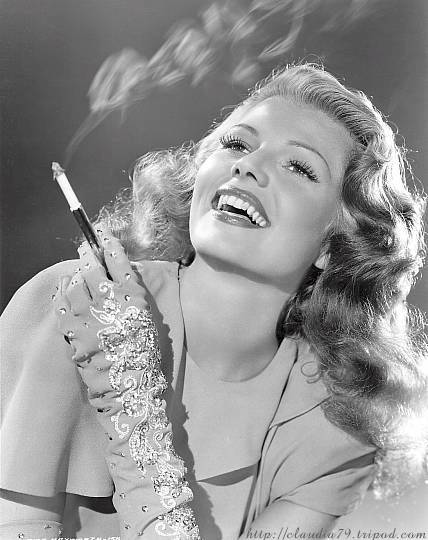 FEEDBACK!
FEEDBACK!
WARNING: Smoke is Hazardous to the Enemy's Health!
Subj: Airborne Smoke System
Date: 98-09-01 15:21:40 EDT
From: XXXXXX@CBDCOM-EMH1.APGEA.ARMY.MIL (XXXXXXX)
To: XXXXXX@aol.com (XXXXXXX@aol.com')
I read with great interest your discussion of the use of smoke for forced-entry operations during Normandy etc. and must state that my first reaction during the opening scene of Saving Private Ryan was the same. Certainly many Soldiers lives could have been saved if planners accounted for the need for obscuration in "OVERLORD".
Your piece points out the need for an obscurant capability to be deployed anytime our troops are at their most vulnerable.
I don't know what the solution should be for the shortfall you have identified (you have good ideas), but I do believe that your observations need to be entered into the system where combat developers and materiel developers can address the issue.
My suggestion would be that you follow up by pushing this issue up the chain of command, writing to professional journals, and contacting the Directorate of Combat Developments at the Infantry School, Ft. Benning, GA, and letting them hear your ideas. TRADOC runs with the ball on mission shortfalls with the idea being that a new materiel solution is the last resort.
Good luck!!, and thanks for taking up this issue. If we can be of any assistance please let us know.
Major XXXXXXXX
